Growing Tulips from Bulbs: Tulip Care and Maintenance 101
Are you growing tulip bulbs in the garden this spring? This garden guide has everything you need to know about growing and caring for tulips.
Tulip flowers are one of my favorite symbols of spring, with their vibrant colors and uniquely shaped blooms. I love them so much that I decided to grow them in the raised bed garden a few years ago to bring tulips into the house whenever they bloomed.
Whether you’re a beginning gardener or have been growing these spectacular spring bulbs for years, these tips will help you choose the best bulbs to care for and maintain your gorgeous flowers throughout the growing season and years to come.
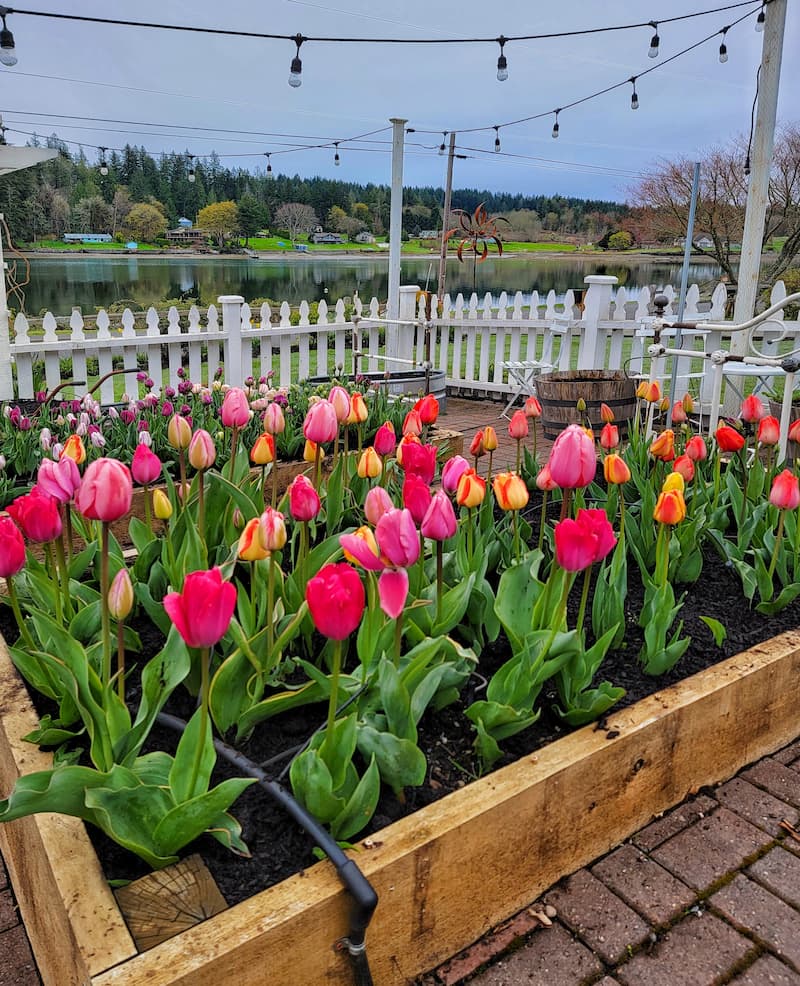
As an Amazon affiliate, I earn from qualifying purchases at no extra cost to you. My blog contains other affiliate links for your convenience as well. Click here to read my privacy policy.
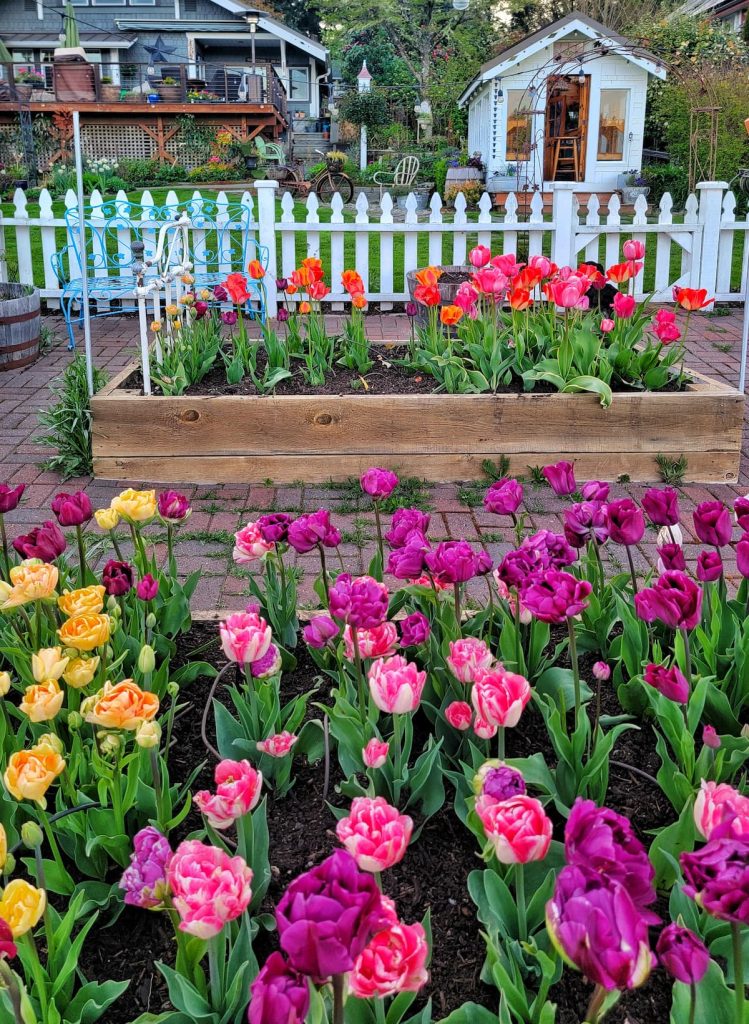
About Tulips
Tulips are perennial plants that grow in early spring gardens and thrive in climates with cold winters and dry summers. The life cycle of a tulip begins when its bulb is planted in the fall to ensure it experiences the winter chill.
How Tulips Grow
Tulips grow from flower bulbs, which store the nutrients and energy necessary for the plant’s growth and bloom the following spring.
The bulbs are planted in the ground in the fall, before the first frost, allowing them to establish roots in cool temperatures.
The plant bulbs remain dormant under the soil throughout the winter, surviving the cold that triggers their development.
The bulb breaks dormancy as the temperatures warm up in the spring, creating a rapid growth phase.
Shoots emerge from the soil, followed by leaves and tulip flowers. This cycle is driven by the energy stored within the bulb. This is why post-bloom care is essential for replenishing the bulb’s energy reserves for next year.
After blooming, tulips enter a period of dormancy once more, resting until the cycle begins again the following year.
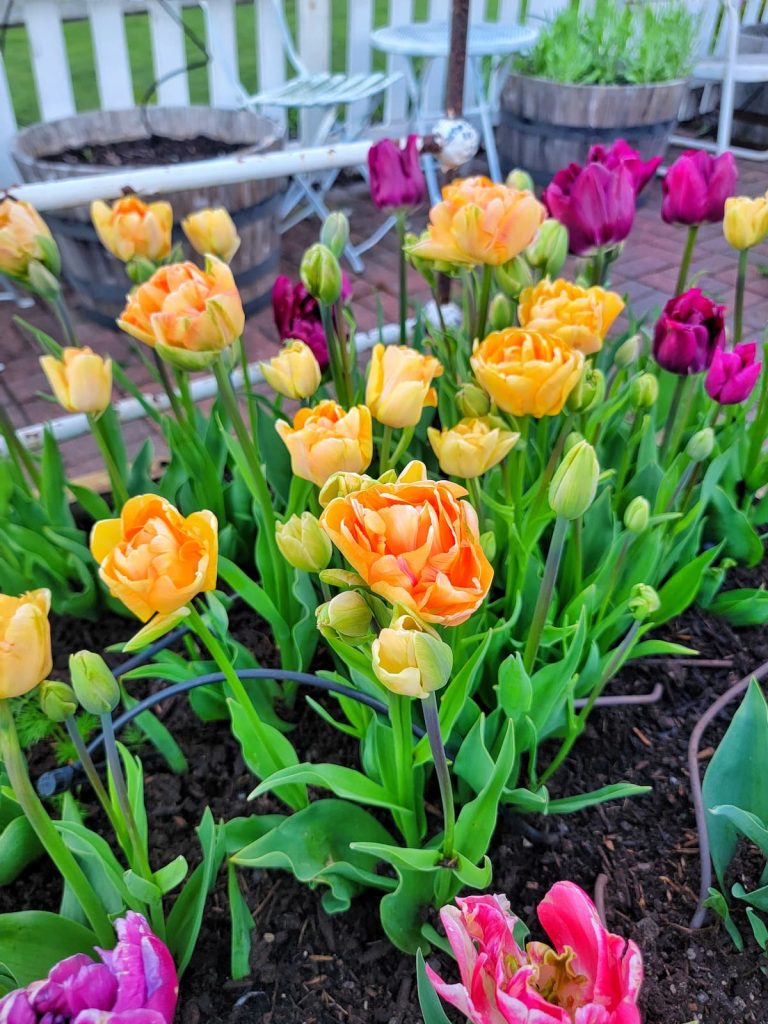
Are Tulips Annuals or Perennials
Tulips are perennials, meaning they can return and bloom for several years. However, their longevity greatly varies depending on the different types of tulips and the growing conditions.
In their native habitat and ideal conditions, tulips return and bloom each spring. However, tulips may not be as reliable in many gardens after their first year, especially in warmer climates or less-than-ideal conditions.
They may act more like an annual plant. This can be because certain tulip varieties are being developed for their stunning flower head rather than their ability to return year after year.
In some climates, the lack of cold winter temperatures can also prevent tulips from entering the dormancy cycle necessary for reblooming.
If you want your tulips to come back each year like that of a perennial plant, choose tulip varieties that are more likely to naturalize and return.
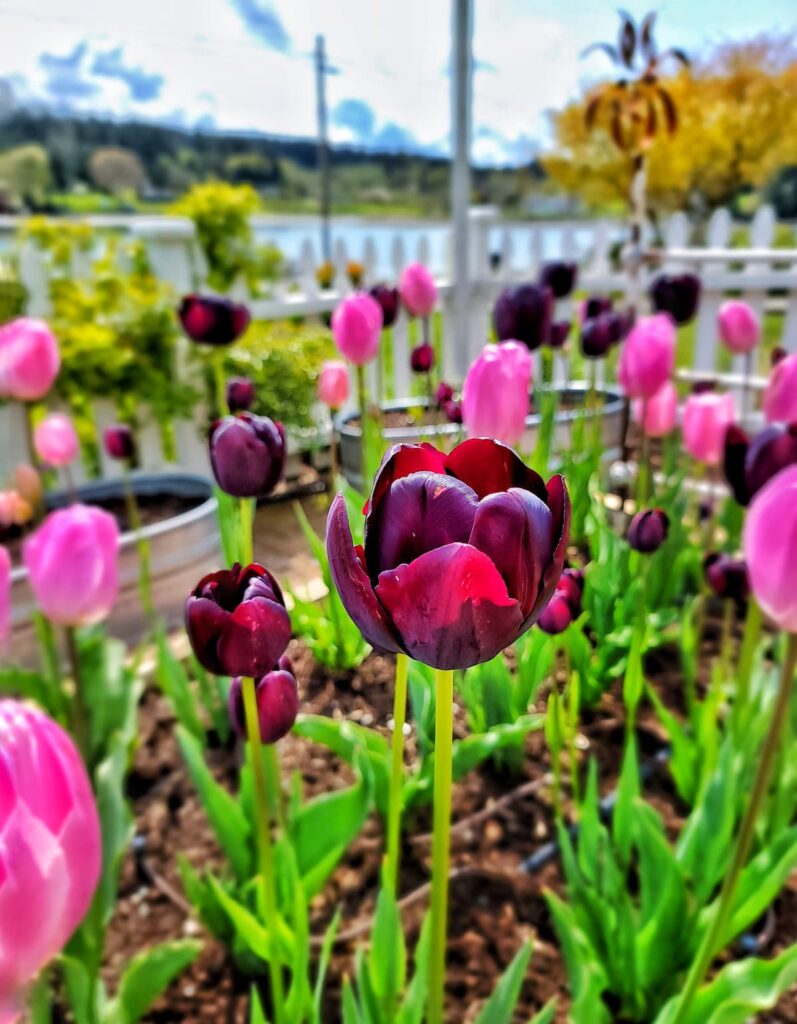
Is it Easy to Grow Tulips in a Garden?
Growing and caring for tulips in a garden is generally considered easy and beginner-friendly, making them popular for beginning gardeners.
Tulips thrive in various climate zones and soil types if the soil is well-draining. There are several critical steps for healthy tulips:
Once the new bulbs are planted, they need minimal care over the winter.
After the tulips bloom in the spring, the main task is deadheading the spent flowers. It’s essential to leave the foliage until it turns yellow and dies naturally. This process helps the bulb recharge for the next growing season.
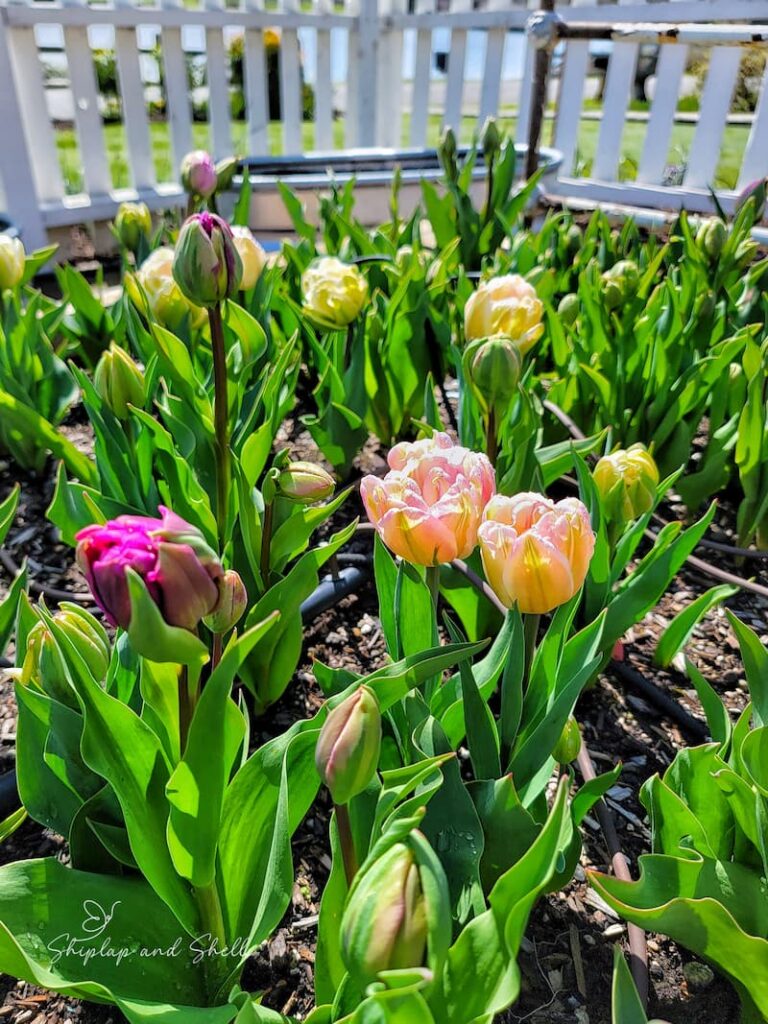
A Few Challenges to Consider
Tulips are generally low-maintenance, but there are a few common problems to consider when growing and caring for these spring bulbs.
The first risk is a bulb rotting in the ground due to overly wet conditions.
My biggest challenge when growing tulips is the potential for pests. Squirrels and other rodents may dig up your tulip bulbs. The moles move my bulbs from under the ground so they’re no longer in a straight row in the cut flower garden.
And then there are the pesky deer, who are always hungry for tulips and love to eat them. Cover the planted area with chicken wire or use a deer repellent in dry weather.
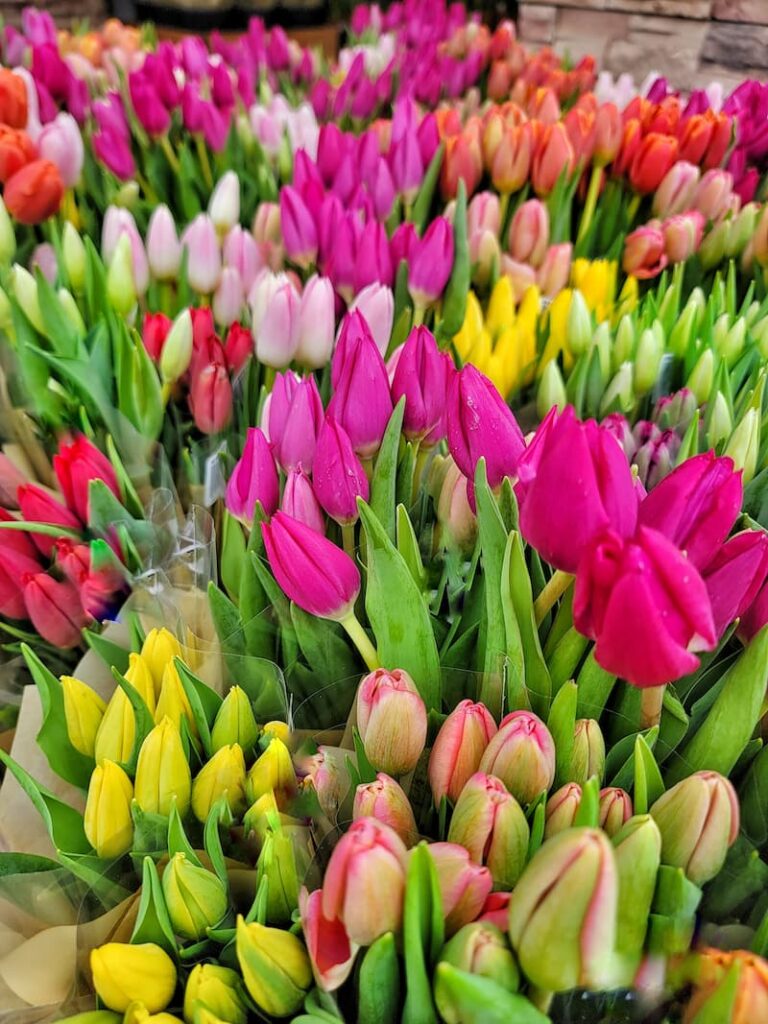
Choosing Tulip Varieties
There are many tulip varieties in various colors, shapes, and sizes. Some of the colors that tulip varieties come in are red, orange, purple, white, yellow, and pink.
Tulips are categorized into several types, each offering unique characteristics, colors, and bloom times. Here are some of the most popular tulip varieties that gardeners love to grow.
Types of Tulips
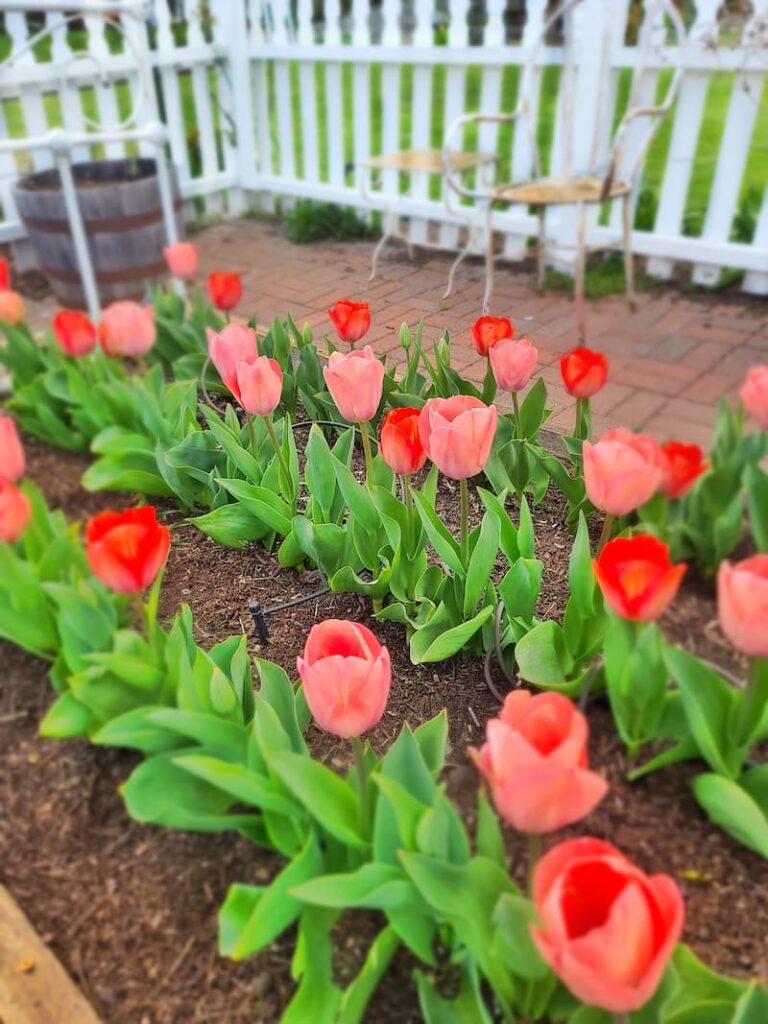
Single Early Tulips
These colorful tulips bloom in early spring. They have single, cup-shaped flowers on short, strong stems. Single tulips come in various colors and are known for their ability to withstand cold, windy conditions.
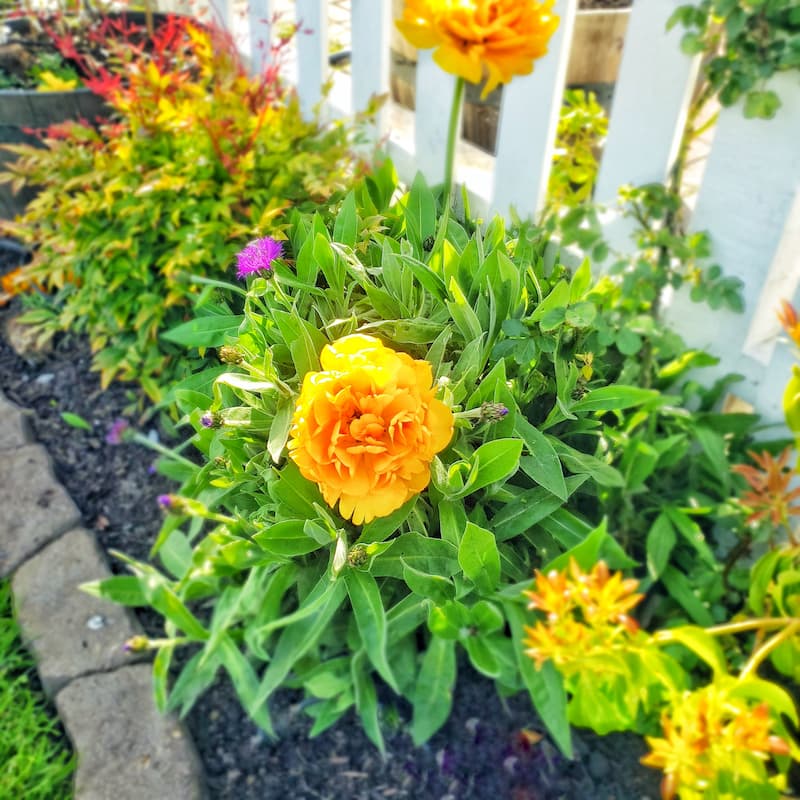
Double Tulips
These spring flowers bloom in early spring and are known for looking like peony tulips with their double flowers. They provide a lush, full look and come in vibrant and pastel colors.
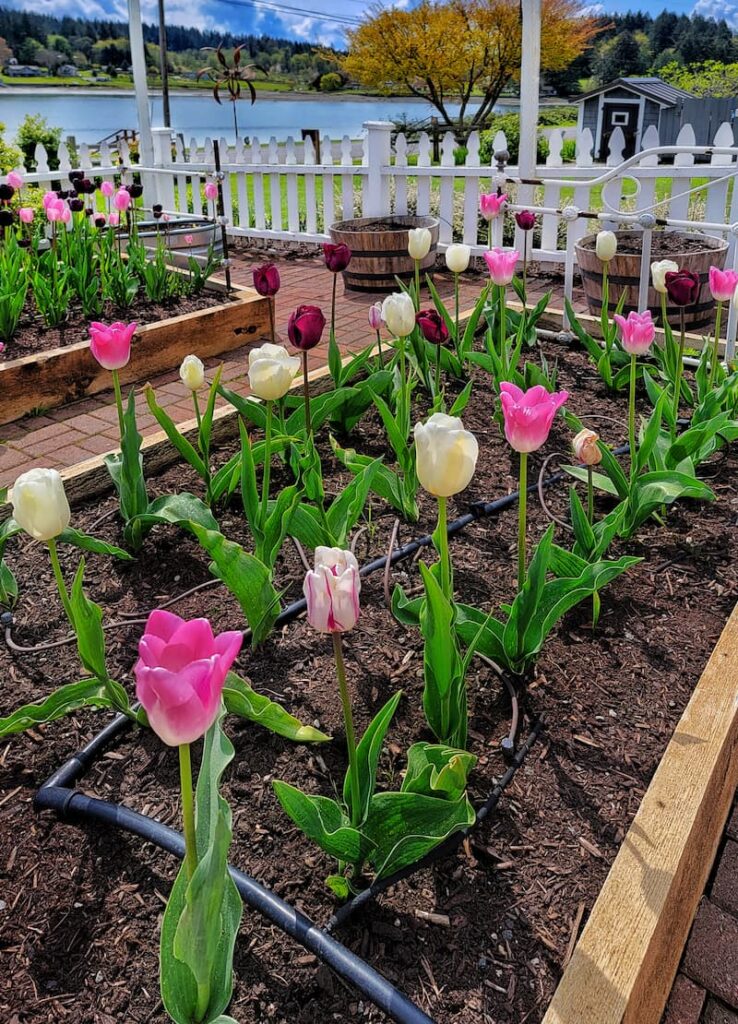
Triumph Tulips
Triumph tulips result from crossing Single Tulips with later flowering varieties, producing a wide range of colors. Their strong tulip stems make them excellent for cut flowers and mid-spring blooms.
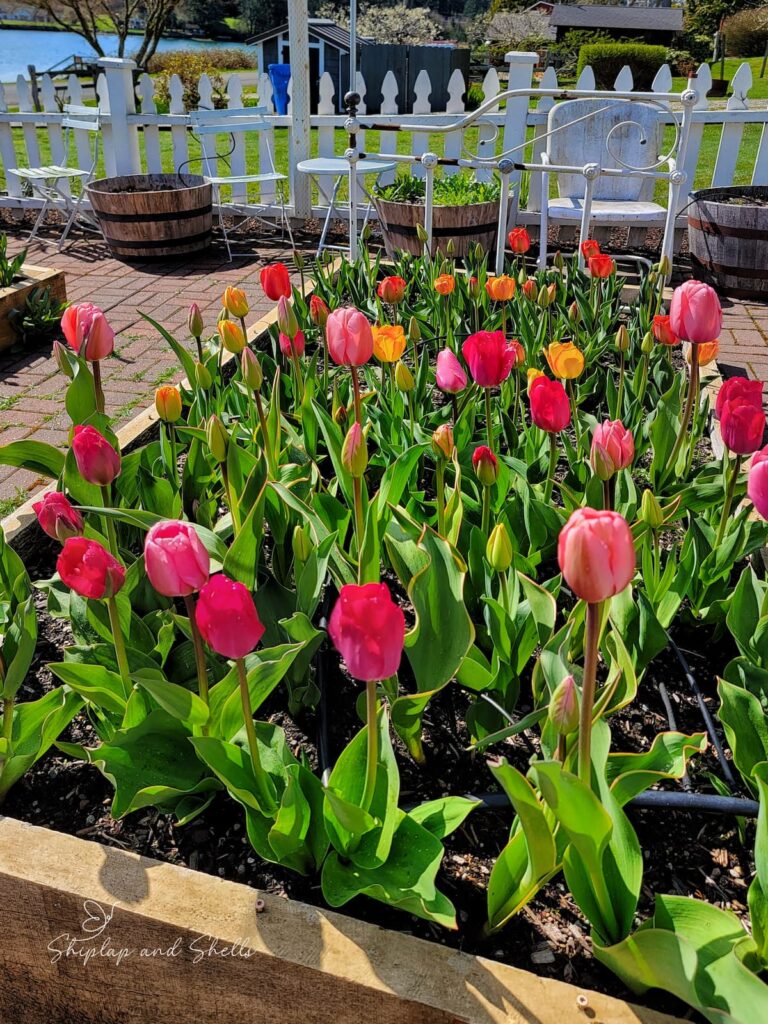
Darwin Hybrid Tulips
Renowned for their large, brilliantly colored blooms on tall stems, Darwin Hybrids are perfect for making a statement in the garden.
They bloom in mid-spring and are known for their durability and ability to return for several years in ideal conditions.
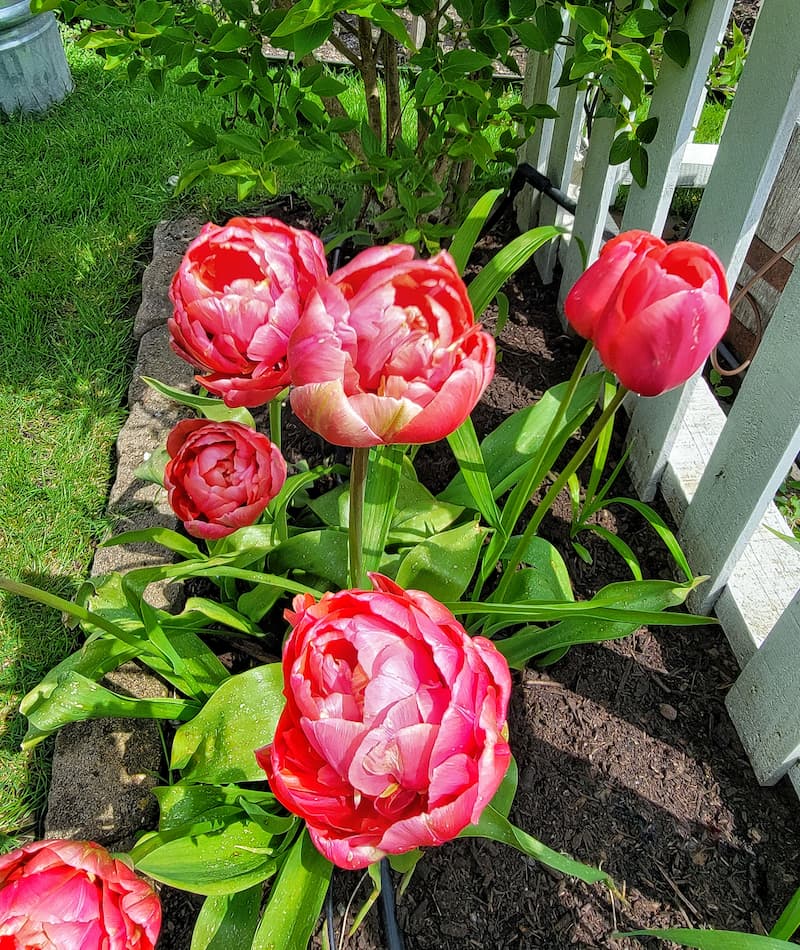
Single Late Tulips
These tulips have large, classic shapes and are among the last to bloom in spring. They feature a wide range of solid and blended colors and have long flower stems, making them ideal for a beautiful bouquet.
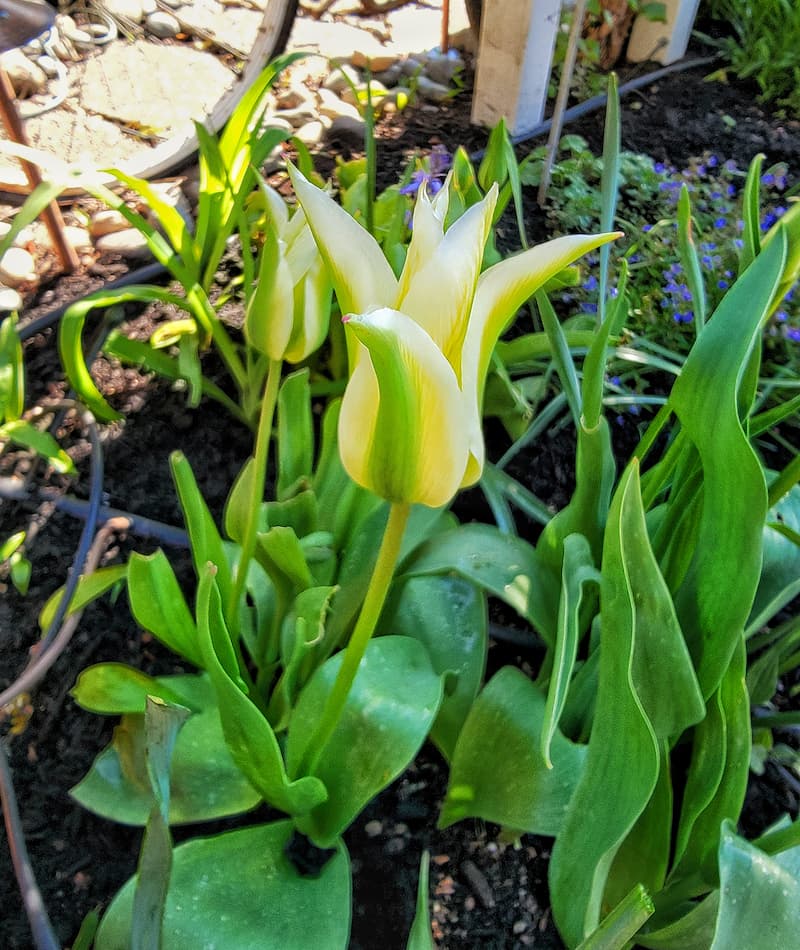
Lily-Flowered Tulips
These elegant tulips bloom in late spring and are characterized by pointed, reflexed petals that resemble lilies. They have tall, slender stems and are available in various colors.
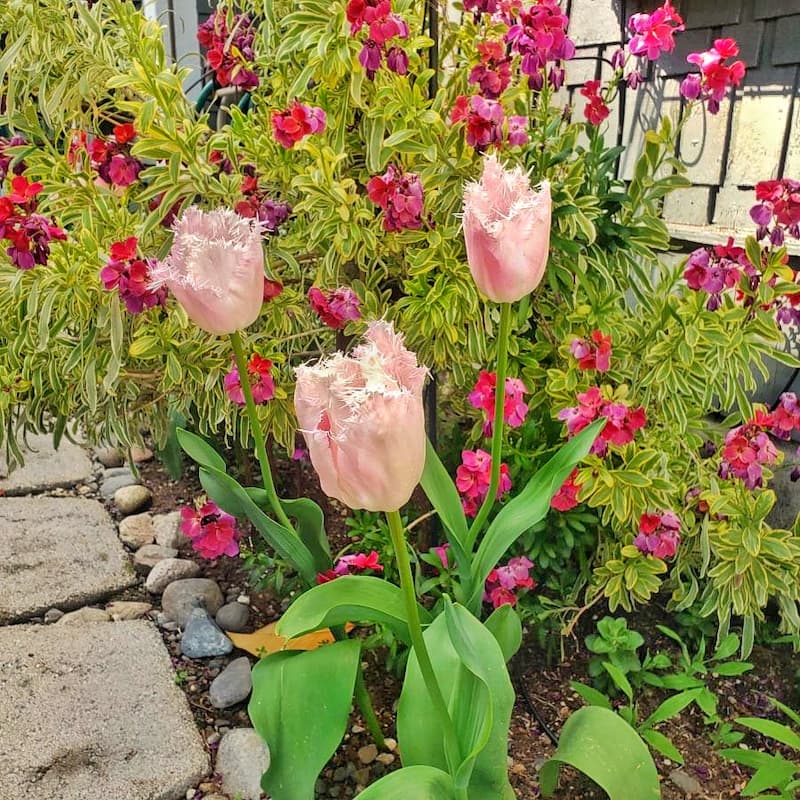
Fringed Tulips
Also known as Crispa tulips, these feature fringed or ragged edges on their petals, adding texture and interest. They bloom in late spring and come in a range of colors.
Parrot Tulips
Parrot tulips are named for their intricate, ruffled, and feather-like petals. They are available in vibrant and unique color combinations and bloom in late spring. Their dramatic appearance makes them a favorite for garden focal points and cut floral arrangements.
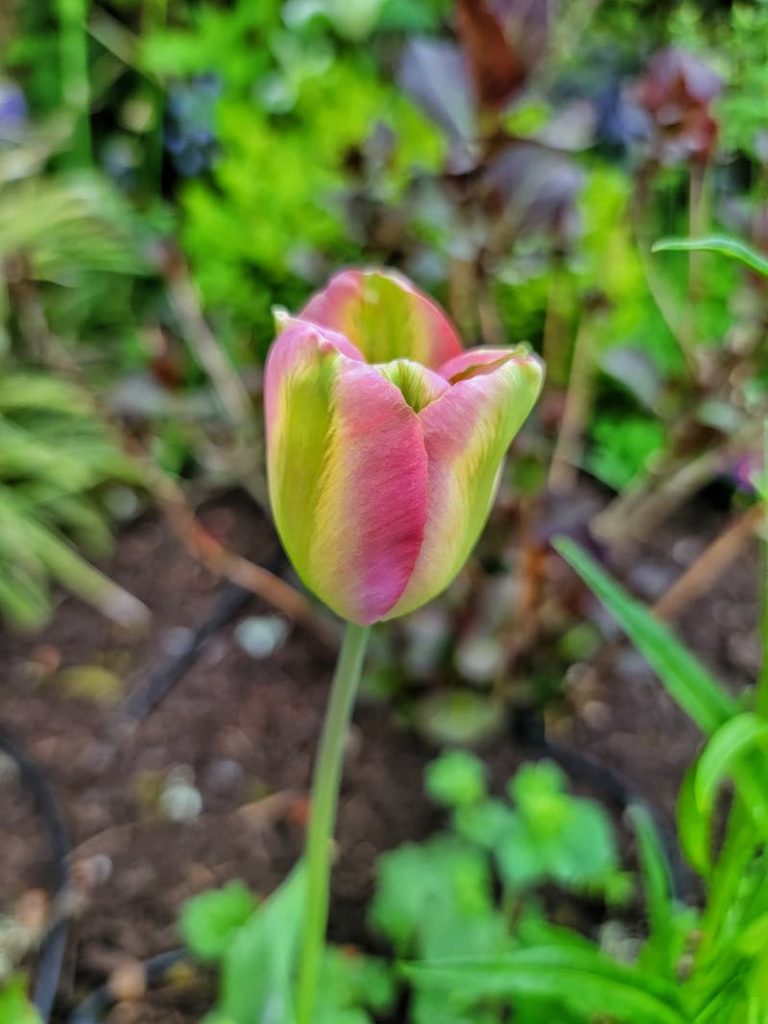
Viridiflora Tulips
Viridiflora tulips are distinguished by their green streaks running through the petals. Blooming in late spring, their contrasting colors offer an unusual and striking look.
Species Tulips
Also known as wild tulips, these are the original wild ancestors of the modern hybrid tulips. They are generally smaller, more delicate, tough, and often perennial, naturalizing well in gardens.
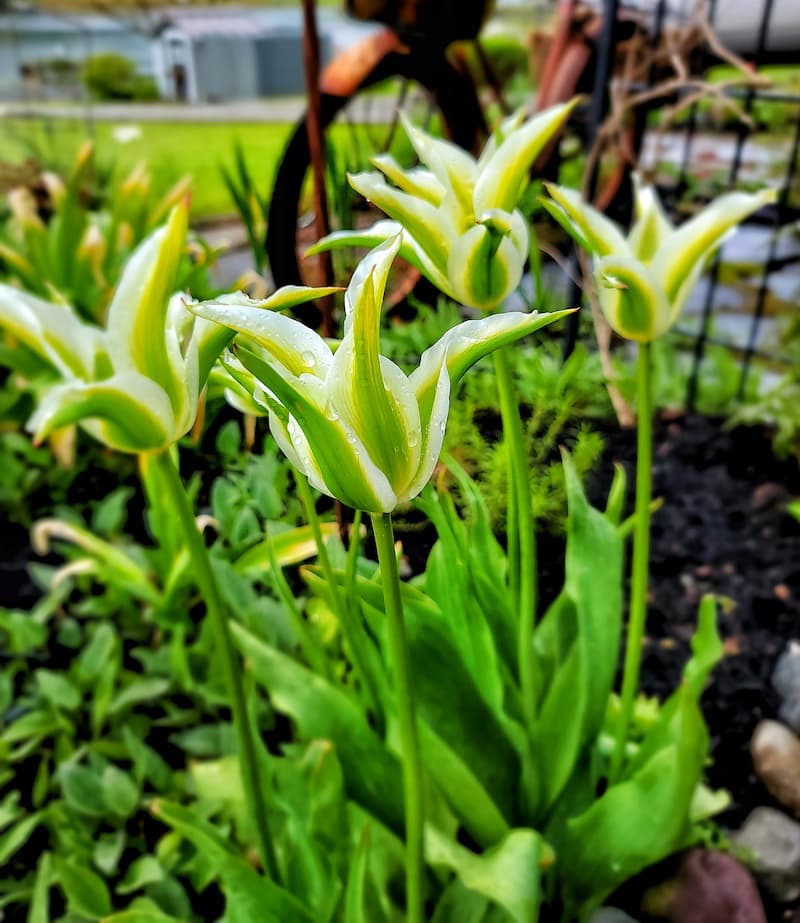
Tulips with Pest and Disease Resistance
Some tulip varieties are more resistant to pests and diseases. Researching and selecting these varieties can save you from frustration.
If your garden is prone to pests like squirrels or deer, consider varieties that are less appealing to them. Some tulips, especially species or those with a more subtle appearance, can be more resistant to wildlife.
Longevity and Naturalization Tulip Choices
While many tulips are treated as annuals and replanted yearly, some varieties are more likely to come back or naturalize, meaning they spread and return for several years.
If you’re looking for a more sustainable option, research species tulips or those known for their perennial qualities.
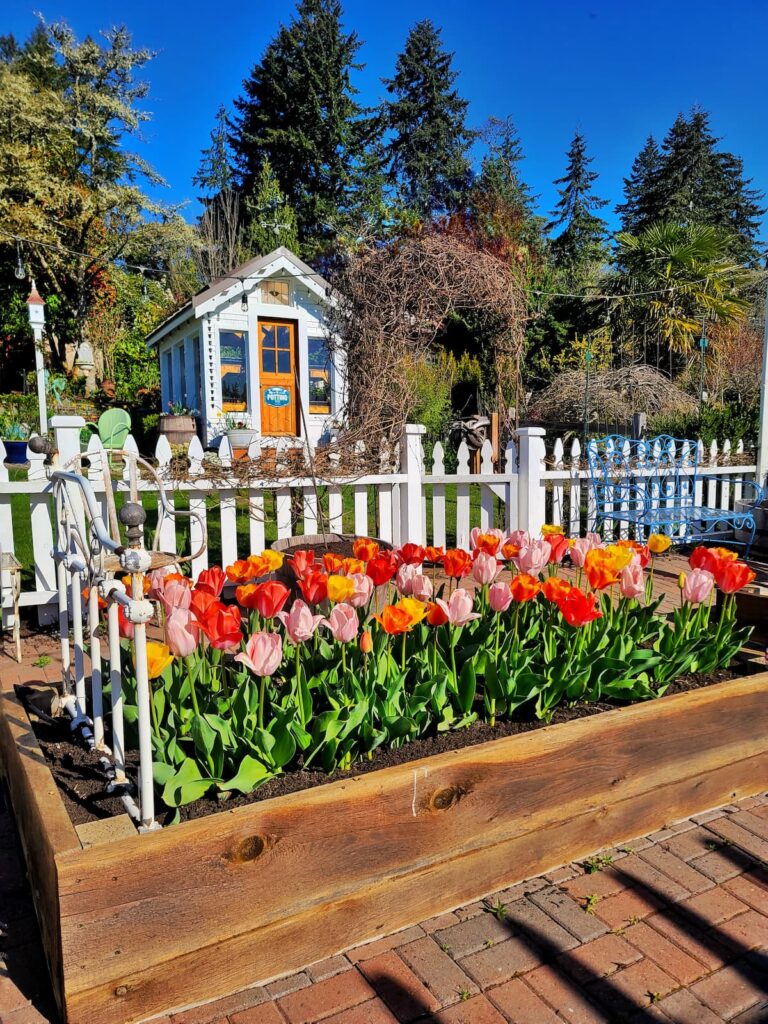
Selecting for Color Coordination
Garden Theme and Color Harmony
Decide on a color theme for your garden. Do you prefer a calm, monochromatic scheme or a vibrant, multicolored garden bed? Choosing tulips that fit your theme will create a cohesive look.
Consider colors that complement each other. Use a color wheel to find harmonious color combinations. Adjacent colors will give you a more harmonious look, while opposite colors will make a more striking contrast in your garden.
Bloom Time
If you want a coordinated color display, ensure the tulips you select bloom simultaneously. Mixing early, mid, and late-spring bloomers in the same color palette can extend the color throughout the season.
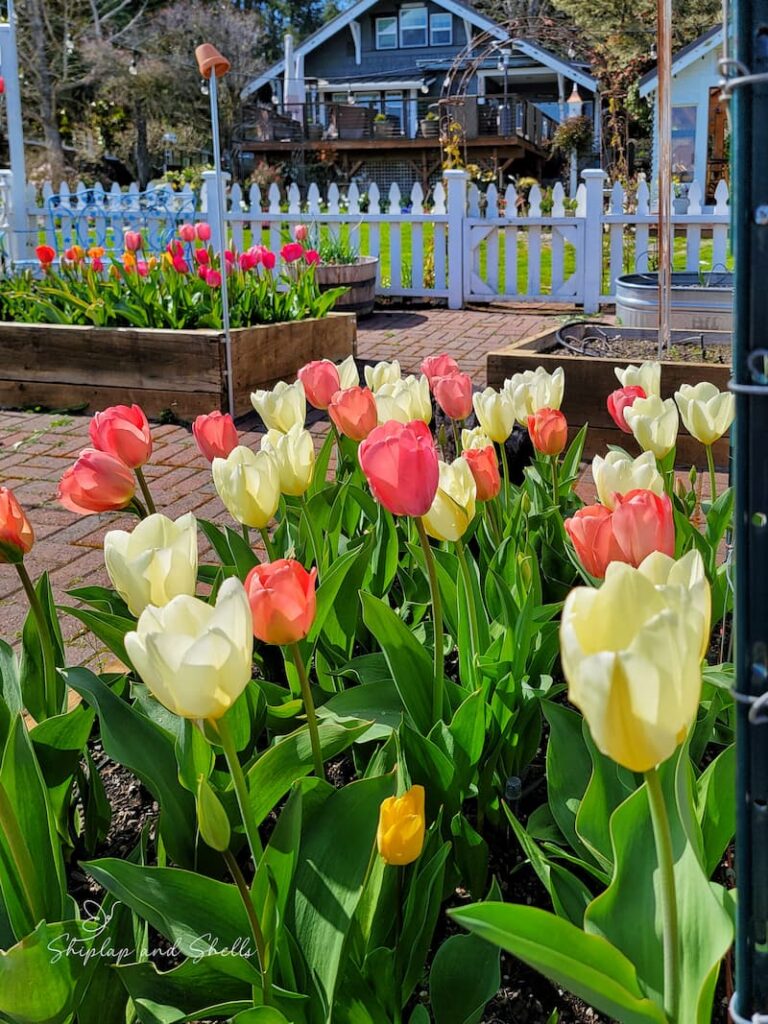
Plan Your Tulip Varieties By Height and Structure
Garden Structure
Plan your garden layout by height to ensure all tulips are visible. Taller varieties should go at the back of beds or in the center of island beds, with shorter ones towards the front or edges.
Visual Impact
Use height to create visual interest and depth in your garden. A staggered arrangement can lead the eye through the space, making your garden appear larger and more dynamic.
Wind Exposure
Consider the height of your garden’s exposure to wind. Taller varieties may need sheltered spots or support to prevent damage from strong winds.
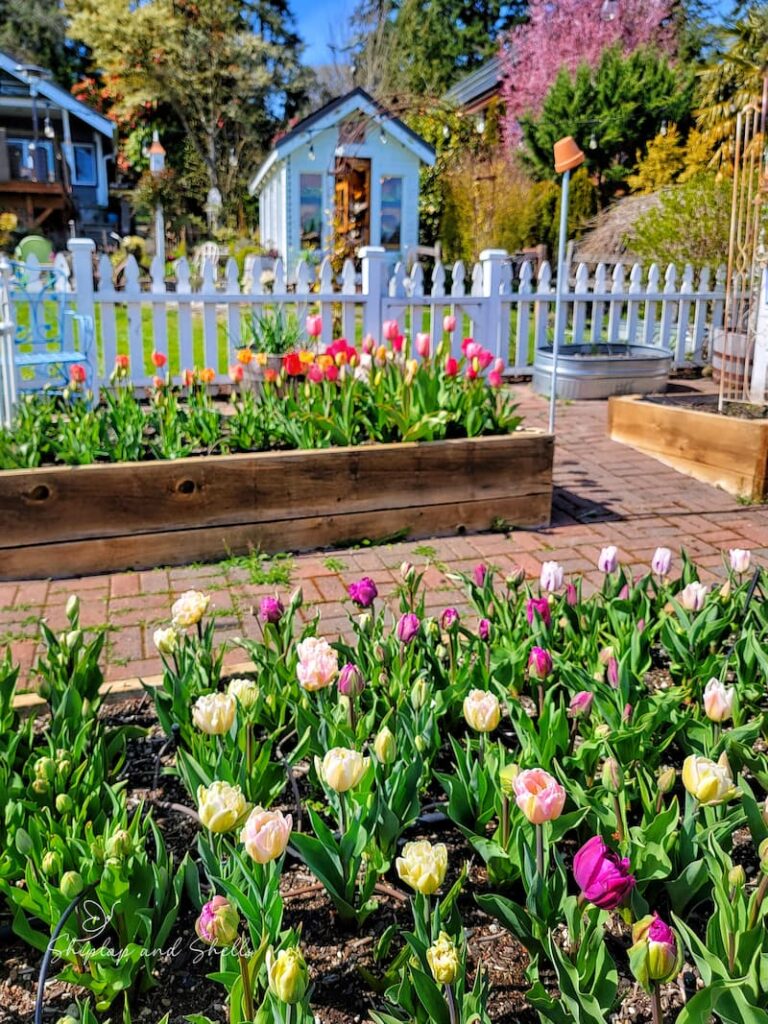
Soil Conditions
Tulips prefer well-drained soil, so if your garden bed soil is heavy or clay-like, amend it or choose more adaptable tulip varieties.
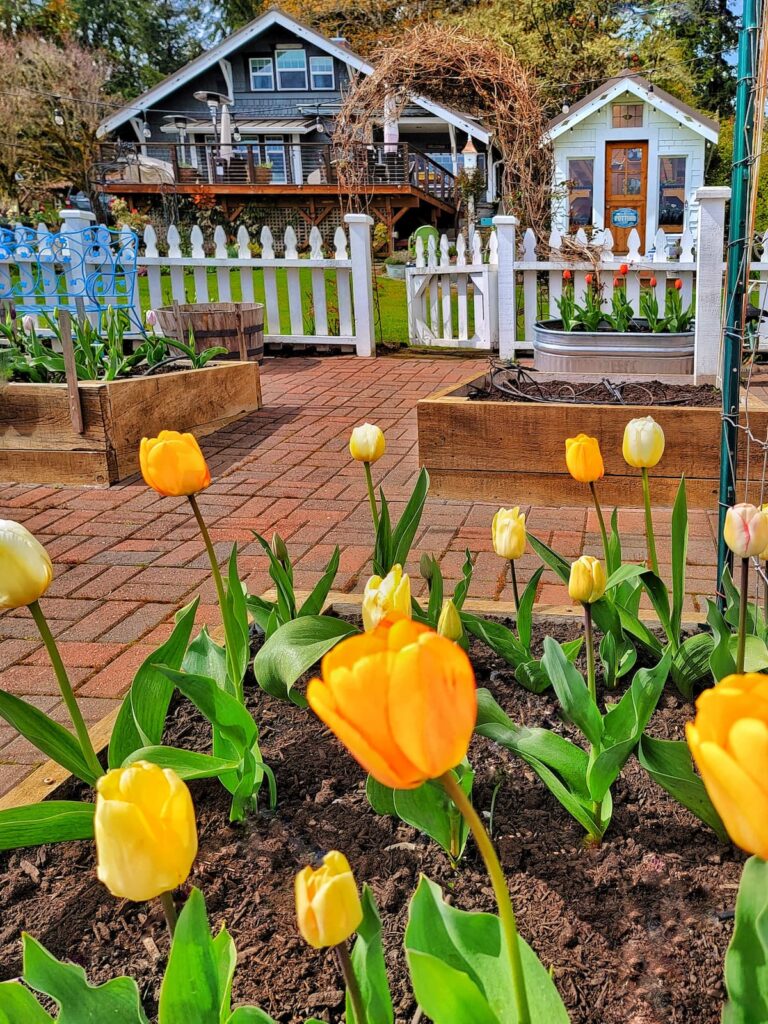
Hardiness Zones and Climate Considerations
Tulips are versatile flowers that can be grown in a wide range of climate zones, but they have specific climate preferences that can affect their performance and longevity.
Ideal Climate Zones for Tulips
Tulips thrive best in USDA hardiness zones 3 through 8 in the United States. These zones provide the cold winter temperatures tulips need to break dormancy and the warm spring conditions they require to bloom.
Gardeners in these zones often find that tulips perform well with minimal additional care, especially if the bulbs are planted at the correct depth and in garden soil with drainage.
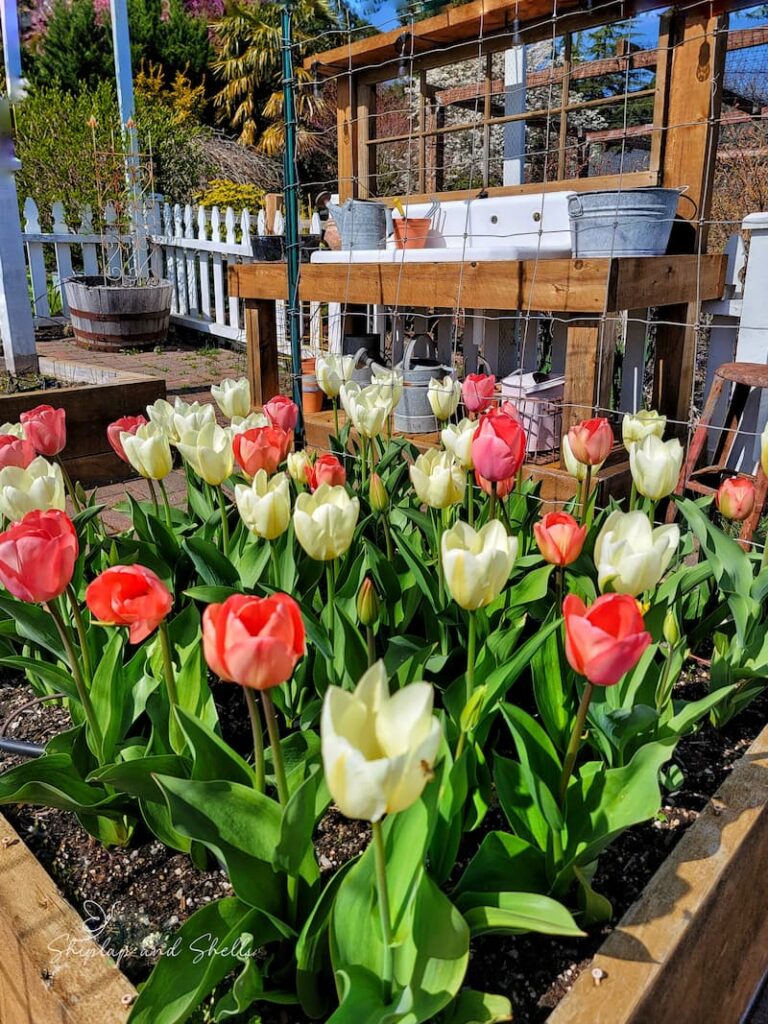
Growing Tulips in Warmer Climates
Gardeners in warmer climates, such as USDA zones 9 and above, can still enjoy tulips, but they may need to treat them as annuals or provide a simulated winter chill period.
This is done by chilling tulip bulbs in the refrigerator for 12 to 16 weeks before planting them in the garden or containers.
After blooming, these tulips are often removed, as the warm temperatures and lack of a cold dormant period in these climates make it difficult for the bulbs to regenerate and bloom again the following year.
Considerations for Various Climates
Garden Supplies and Tools
Check out my favorite garden supplies and tools for the growing season. Whether you’re looking for potting soil or deer repellent, you’ll find what I use in my own garden.
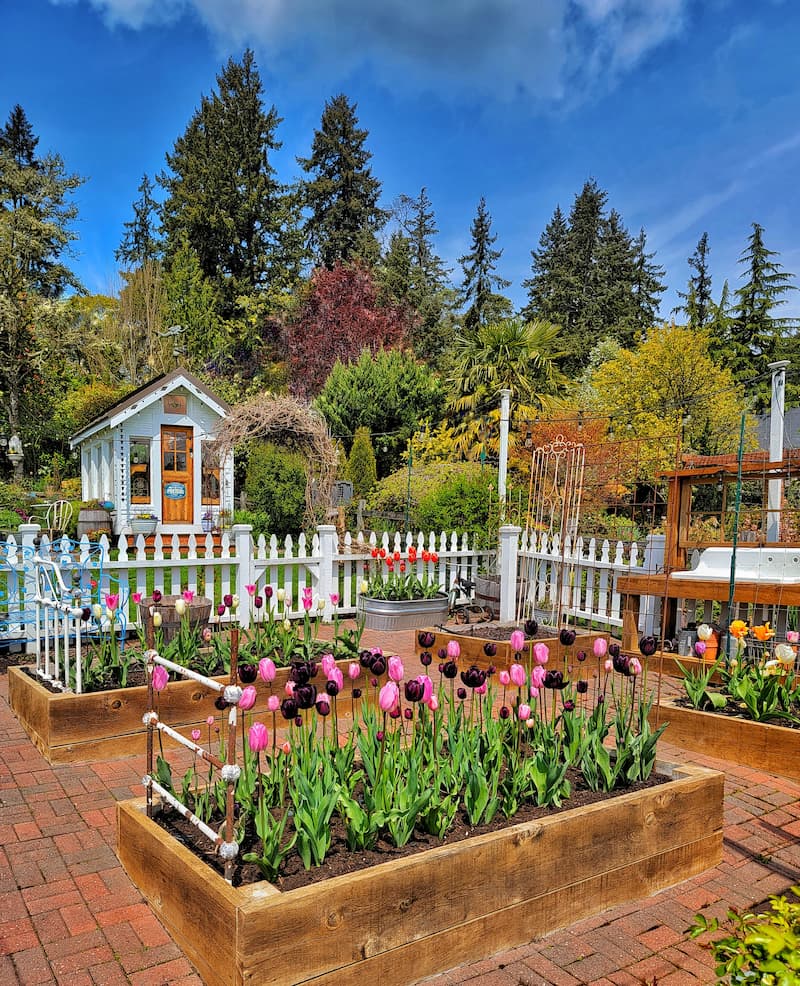
Planting Tulips
The journey of a tulip from bulb to bloom spans the cooler months, beginning with planting in the fall, several weeks before the ground freezes, for a stunning spring tulip view.
When to Plant Tulip Bulbs
The optimal time to plant tulip bulbs is in the fall, several weeks before the ground freezes. This timing allows the bulbs to establish roots before winter sets in. Depending on your geographic location, this generally means planting from late September through November.
In cooler northern climates, plant bulbs in September or October. In warmer southern climates, where cold temperatures arrive later, planting can often be delayed until late October or even November.
The key is to ensure bulbs are planted when soil temperatures have cooled down to below 60°F (15°C) but well before the first hard frost. This cooling period is crucial for tulips, as it triggers the necessary dormancy period that prepares the bulbs for spring growth and flowering.
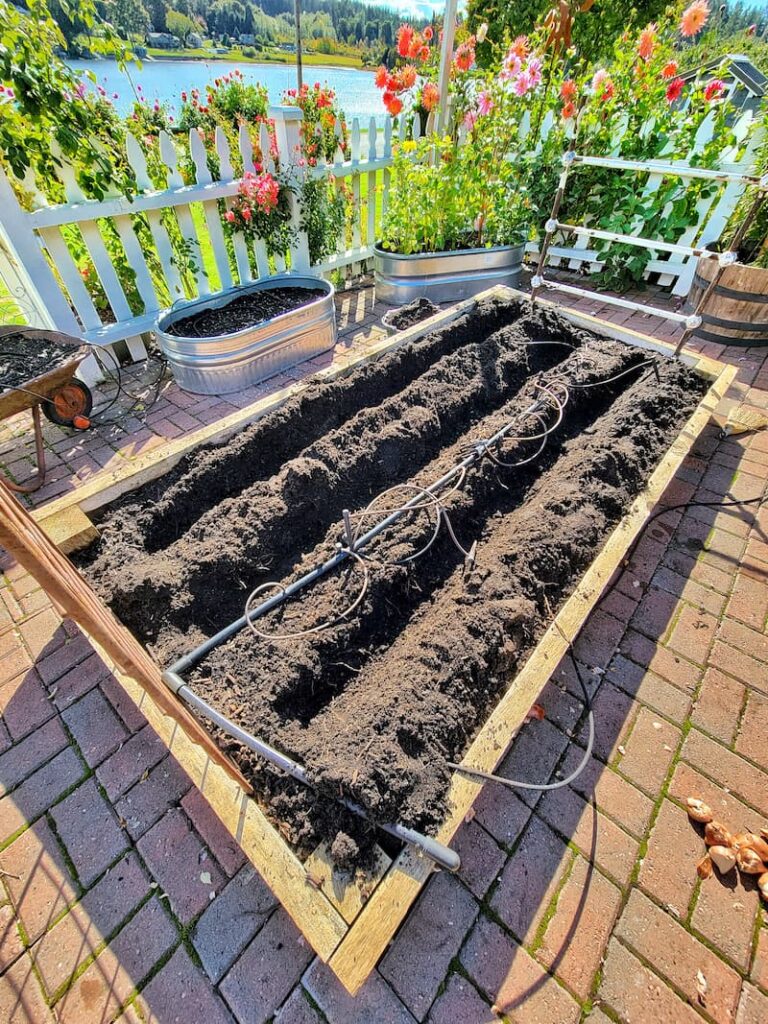
Soil Preparation
As mentioned earlier in the post, tulips perform best in well-drained soil. Waterlogged conditions can lead to bulb rot and fungal diseases.
To prepare the soil for planting, incorporate organic matter such as compost or well-rotted manure into the planting hole to improve soil structure and nutrient content. This amendment is particularly important in heavy clay soils, which can impede drainage, or sandy soils, which may not retain sufficient moisture and nutrients.
The ideal soil pH for tulips is slightly acidic to neutral, ranging from 6.0 to 7.0. If your soil is too acidic or alkaline, you may need to adjust the pH by adding garden lime (to raise pH) or sulfur (to lower pH) according to soil test recommendations.
Loosen the soil to a depth of at least 12 inches (30 cm) to ensure the planting site is well-aerated and facilitate root growth and drainage.
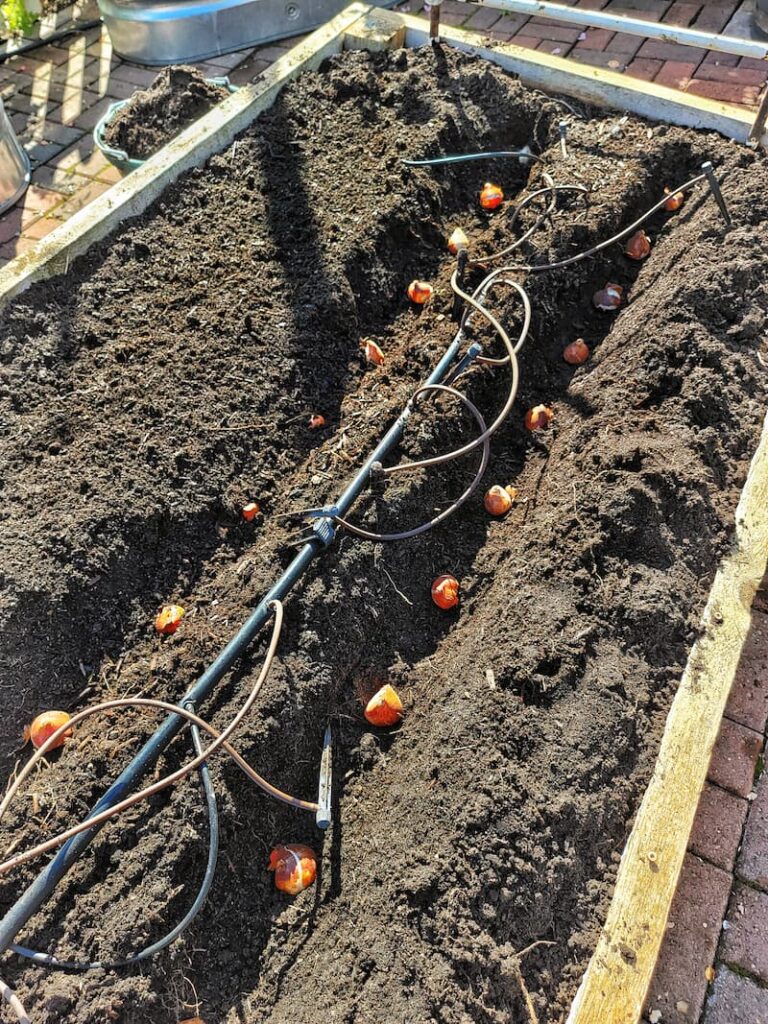
Planting Depth and Spacing
As a general rule, tulip bulbs should be planted at a depth approximately three times their height. This typically translates to a depth of about 6 to 8 inches (15 to 20 cm) from the bulb’s base to the soil surface.
This will give your tulip bulbs adequate protection from harsh winter temperatures and provide the stability bulbs need to develop strong roots.
Spacing between tulip bulbs is also essential for preventing overcrowding and ensuring each plant has enough room to grow. A spacing of about 4 to 6 inches (10 to 15 cm) apart is recommended.
This allows for sufficient air circulation around the plants, reducing the risk of fungal disease, and ensures that each tulip has enough space to display its blooms fully.
When planting in groups or clusters, maintain this spacing to create a dense and colorful display in the spring.
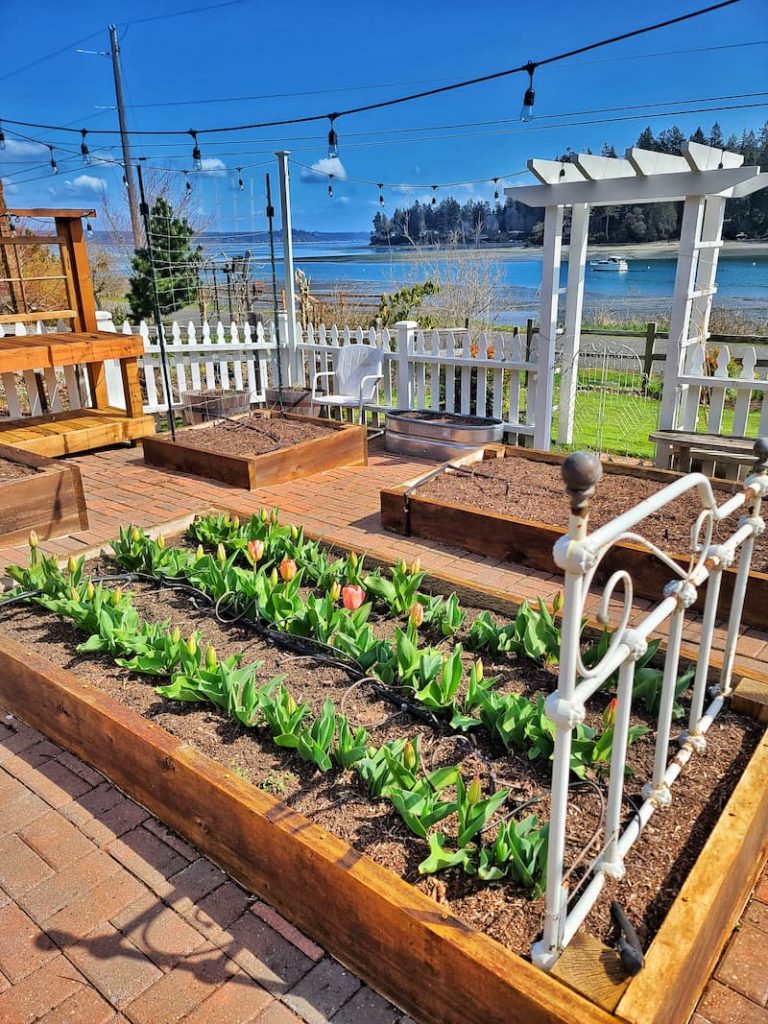
Sun vs Shade: Where Do Tulips Grow Best?
Tulips thrive best in locations that receive full sun to partial sunlight, with at least six hours of direct sunlight each day ideal. These conditions are crucial for tulips to produce the energy they need for robust growth and the best blooms.
While tulips are adaptable and can tolerate some shade, especially in hotter climates where afternoon shade can protect them from the intense heat, too much shade can lead to weak stems, smaller flowers, and an overall diminished display.
Tulips may struggle to bloom in deep shade and become more susceptible to disease and pest problems.
The balance between sun and shade is essential. They should be in an area with morning sunlight and are partially shaded during the hottest part of the afternoon, which is often ideal, especially in regions with intense summer sun.

How Long Is the Tulip Growing Season?
The tulip growing season spans from bulb planting in the fall to bloom emergence in the spring, typically covering a period of approximately six to eight months, depending on the climate and specific tulip variety.
Tulips can bloom anywhere from late March to early May in many regions. The period from when the first green shoots appear to when the tulips are in full bloom is relatively quick, typically occurring over a few weeks in the spring.
This timeline can be influenced by the weather conditions of the particular year, with warmer springs leading to earlier blooms and cooler springs delaying flowering.

Tulip Plant Care Tips and Maintenance
Tulip care and maintenance are vital to ensuring these spring bloomers reach their full potential in beauty and longevity.
After carefully selecting and planting tulip bulbs in the fall, gardeners must navigate through the various stages of growth, from the initial emergence of shoots to the post-bloom period, with attentiveness and care.
Tulips must receive adequate sunlight and hydration and maintain well-drained soil conditions. As the tulips bloom, deadheading spent flowers while leaving the foliage to wither naturally plays a crucial role in energy conservation for the following year’s growth.
Understanding the balance between fertilization, pest control, and disease prevention further enhances tulip health and bloom production.
Seasonal care, such as meeting the bulbs’ cooling needs before planting and preparing for dormancy, is crucial to the cyclical nature of tulip gardening.
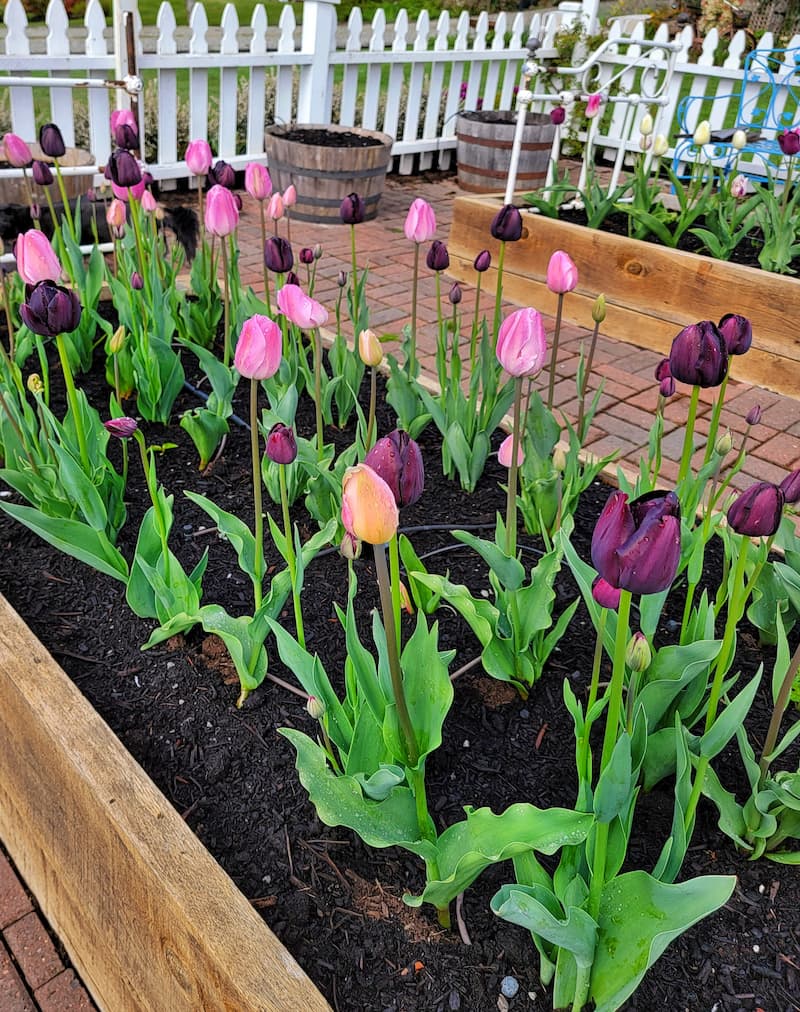
Watering Tulips
Tulips must be kept moist, especially during their active growth phase in the spring, but they should not be waterlogged.
Ensure the soil is lightly moist but not saturated before and during the shoots’ emergence. Once tulips bloom, they can benefit from slightly more water, especially if the weather is particularly dry.
However, allowing the soil to dry out somewhat between watering sessions is essential to prevent bulb rot and fungal diseases, which are more prevalent in wet conditions.
After the flowers bloom and the tulip leaves begin to yellow and die back, significantly reduce the watering. This period of reduced water intake encourages the bulbs to enter dormancy correctly, setting the stage for the next growing season.
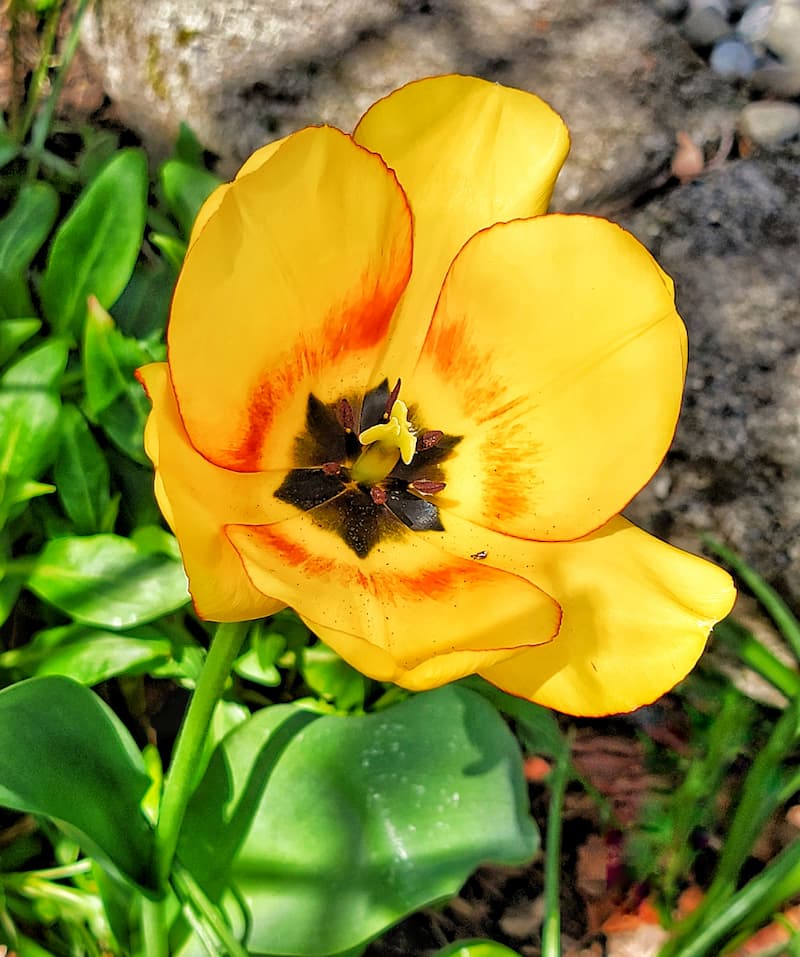
Do Tulips Need Fertilizer?
Tulips can benefit from fertilization, but the timing and type of fertilizer used are essential to ensure healthy growth without encouraging excessive foliage at the expense of blooms.
Before planting tulip bulbs in the fall, incorporate a balanced, slow-release bulb fertilizer or well-composted organic matter into the soil. This initial feeding provides the nutrients necessary for root development and early growth.
In early spring, as shoots emerge, a second application of a low-nitrogen, high-potassium fertilizer can promote vibrant blooms and strong stems. High-potassium fertilizers encourage flowering and overall plant health, whereas high nitrogen levels can lead to lush foliage with fewer or smaller flowers.
Do not over-fertilize, as this can harm the bulbs and reduce blooming.
After tulips have flowered, applying a bone meal or another phosphorus-rich amendment can help nourish the bulbs as they prepare for dormancy. This post-bloom feeding supports replenishing energy reserves within the bulb, which is crucial for growth the following year.
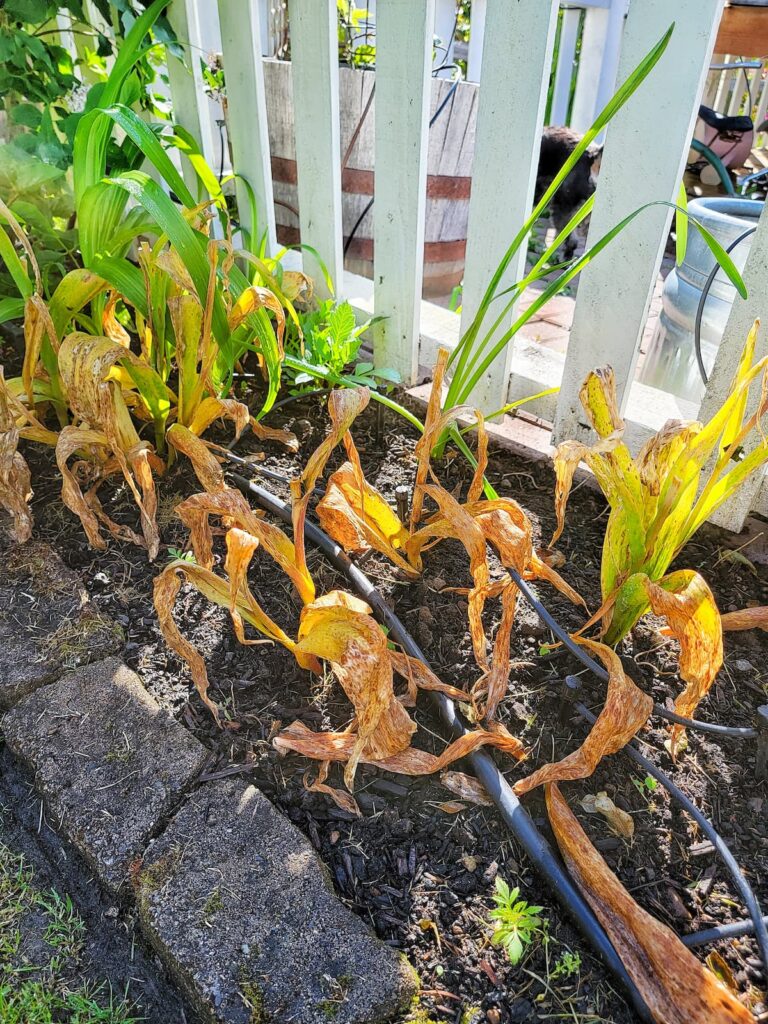
Deadheading & Pruning Tulips
Deadheading involves removing the spent flower heads as soon as they begin to fade and before they set seeds. This process prevents the tulip from expending seed production energy, redirecting it to the bulb’s energy reserves.
To deadhead, simply snip or pinch off the faded flower head at the base of the bloom, careful not to damage the stem or leaves.
Pruning tulips means removing dead or dying foliage once it has yellowed and begun to die naturally. Don’t remove the leaves until they have turned yellow. Until this point, the foliage is still photosynthesizing and feeding the bulb for next year’s growth.
Don’t remove or cut back the leaves while still green, which can weaken the bulb.
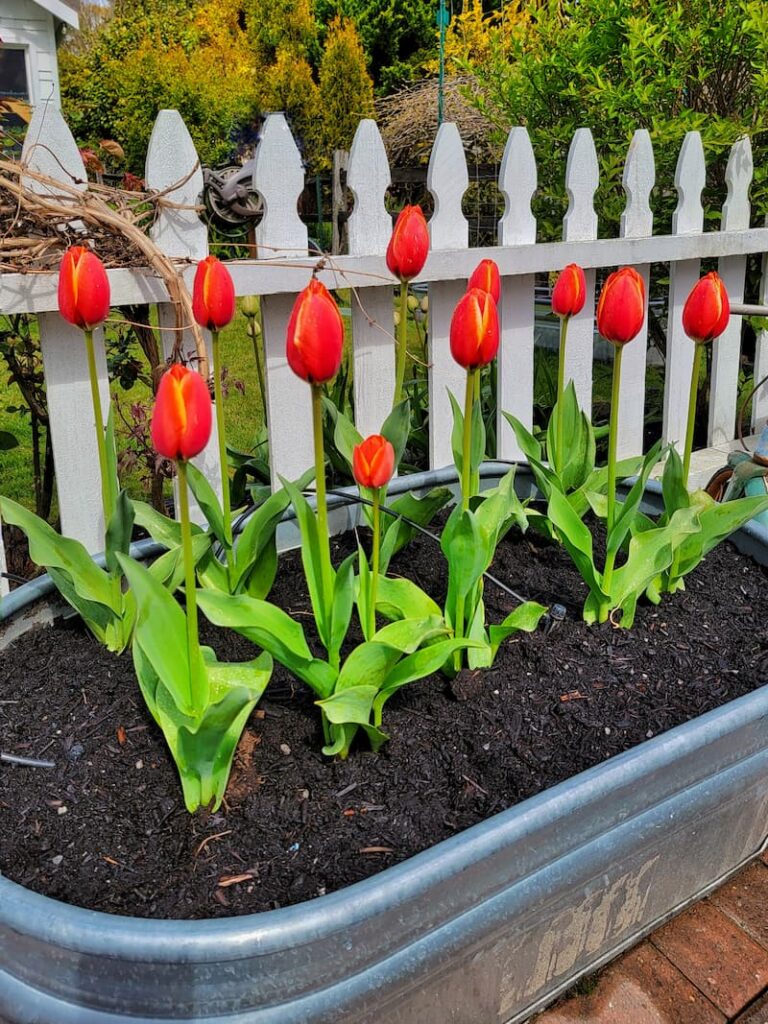
Tulip Disease and Pest Management
Tulips are susceptible to various fungal diseases, such as tulip fire (Botrytis tulipae) and bulb rot, as well as pests like aphids, slugs, and rodents that can damage the bulbs and flowers.
To prevent fungal diseases, practice good garden hygiene by removing debris and fallen leaves, which can harbor fungi.
Ensure proper spacing between bulbs at planting to improve air circulation and reduce humidity around the plants.
Planting bulbs in well-drained soil is vital to preventing bulb rot. If drainage is poor, consider raising beds or adding sand or compost to improve soil structure.
Bulbs should be protected from rodents with barriers like chicken wire and environmentally friendly slug bait to deter pests. Insect pests like aphids can often be controlled with a strong jet of water to dislodge them or use insecticidal soap.
Encouraging natural predators such as ladybugs, birds, and frogs is also beneficial and helps control pest populations.
Regular monitoring and early intervention when problems are detected can prevent minor issues from becoming significant infestations.
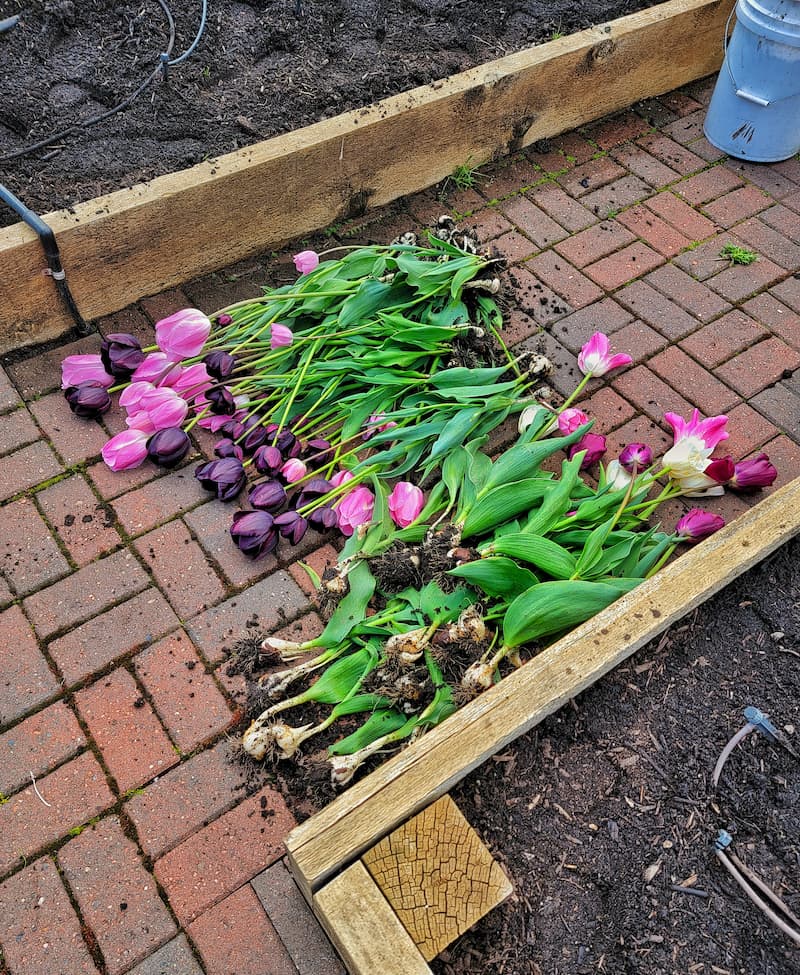
Growing Tulips as Cut Flowers
I’ve been growing and caring for tulips in my cut flower garden for three years. I love creating a bouquet of spring flowers whenever I want! Here are some tips for harvesting tulips indoors.
For fresh cut tulips, select blooms that are just beginning to open. They will continue to open and last longer in water.
Harvest Tulips With the Bulb
After selecting the tulips for my flower arrangement, I harvest the tulips with the bulbs attached. By leaving the bulb attached to the tulip, the length of the stem is longer.
Remember that cutting the tulip flower removes the energy the bulb needs to produce another flower the following year.
Because of this, the bulbs must be replaced to produce more cut flowers. Only the tulip leaves would be produced if the existing bulbs were left in the ground.
Cut the Tulip Stems
Cut the tulip stems to the desired length by snipping at or just above the bulb’s base. Remember that tulips grow a few inches after being cut, so allow for this additional height in your arrangement.
Use a sharp, clean knife or garden shears to make a 45-degree angle cut. This will increase the surface area for water uptake and prevent the stem from sitting flat on the bottom of the vase, ensuring better hydration.
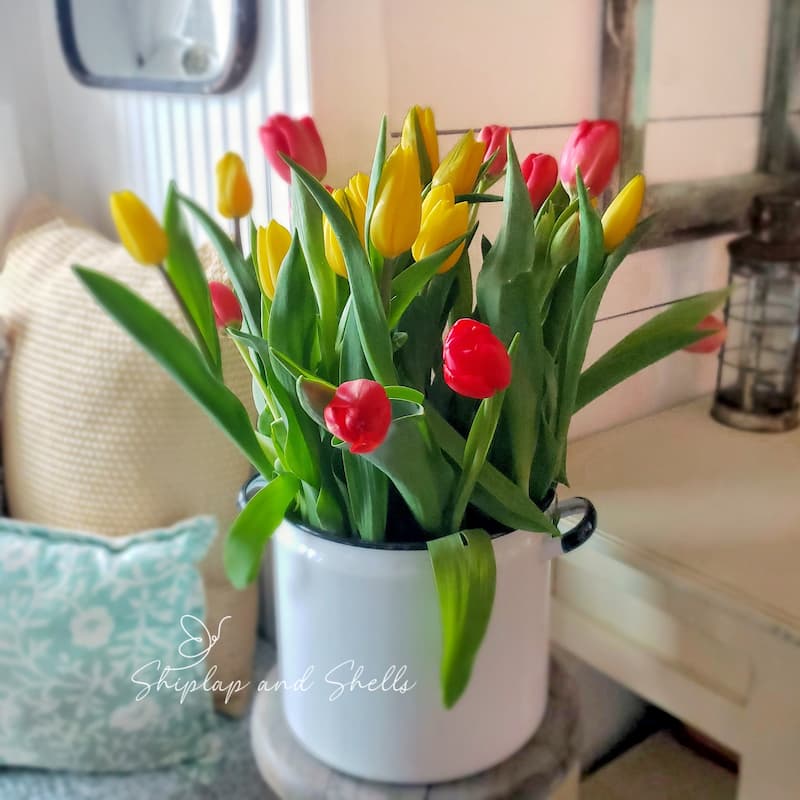
Hydrate and Feed Your Fresh Cut Tulips
Immediately after cutting, place the tulips in a bucket of cool water to hydrate for a few hours before arranging them in a vase. This “conditioning” process helps the tulips absorb water more efficiently and extends their vase life.
Use fresh, cold water in a clean vase and add a flower food (floral preservative) to provide nutrients and inhibit bacterial growth.
Tulip Tip
Drop a penny into the water of a vase of tulips to keep them from drooping.
The copper in the penny acts as a fungicide, killing any bacteria in your vase.
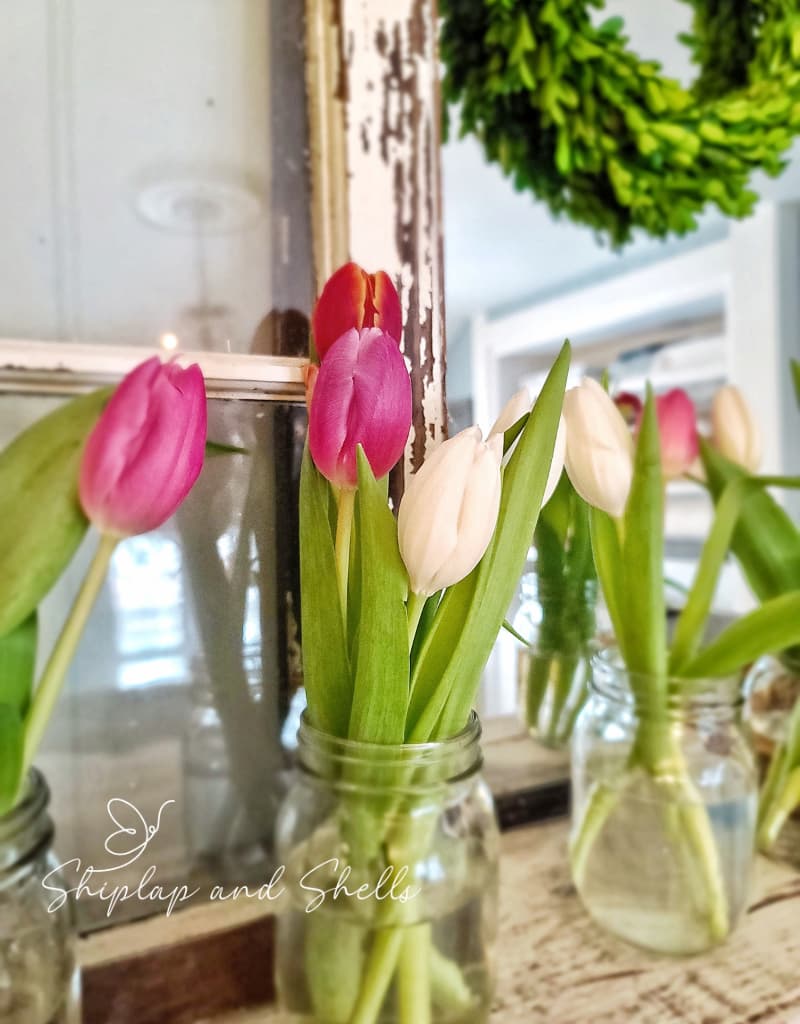
Extend Your Vase Life
Finally, keep the arranged tulips in a cool place and away from direct sunlight and heat sources, which can cause them to fade and wilt prematurely.
Keep your vase of tulips away from ripening fruit. As the fruit matures, it emits ethylene gas, causing the flower petals to drop.
Add fresh water every couple of days for an extended vase life.
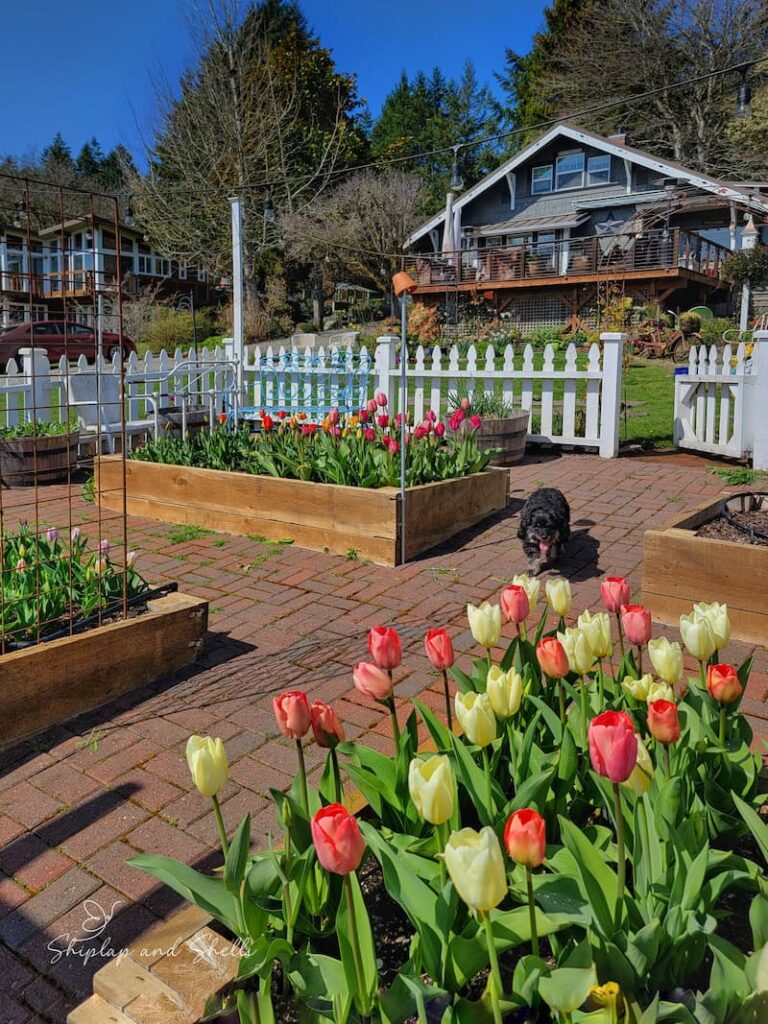
Caring for Tulips After They Bloom
We’ve been talking about growing tulips, but this next section will guide you through caring for them after they bloom in the garden.
How Long Do Tulip Flowers Last?
The longevity of tulip flowers once they bloom can vary, typically lasting between 5 to 10 days, depending on the variety and environmental conditions.
After tulips have bloomed, post-bloom care is crucial for the bulbs’ health and performance in the following year.
Begin by deadheading the spent flowers to prevent the plant from diverting energy into seed production. However, as mentioned earlier in this blog post, leaving the foliage in place is essential until it has naturally yellowed and died back. This period allows the plant to photosynthesize and channel energy back into the bulb for next year’s growth.
During this time, you may reduce watering and apply a balanced, slow-release fertilizer to support the bulbs’ replenishment.
Once the foliage has fully yellowed and detaches easily, it can be gently removed and composted.
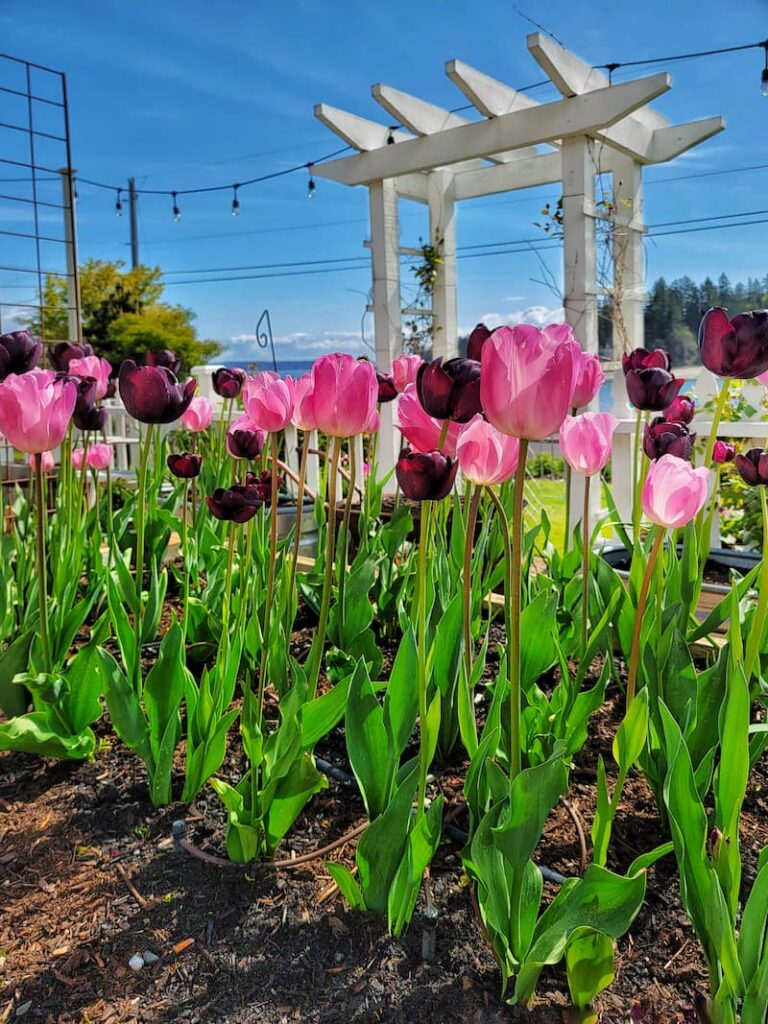
Can you Leave Tulip Bulbs in the Ground All Year?
It is common to leave tulip bulbs in the ground all year. This is especially true in regions with climate conditions that mimic the tulips’ native habitat, such as cold winters and dry summers.
In these environments, many tulip varieties can successfully overwinter in the soil and return to bloom in the following spring. This perennial behavior is more typical of species tulips and certain robust hybrid varieties known for their naturalization ability.
However, in very wet summers or mild winters, the bulbs may be prone to rot or may not receive the necessary cold period to trigger dormancy and subsequent flowering.
In these cases, gardeners may lift the bulbs after the foliage has died back and store them in a cool, dry place over the summer, replanting them in the fall.
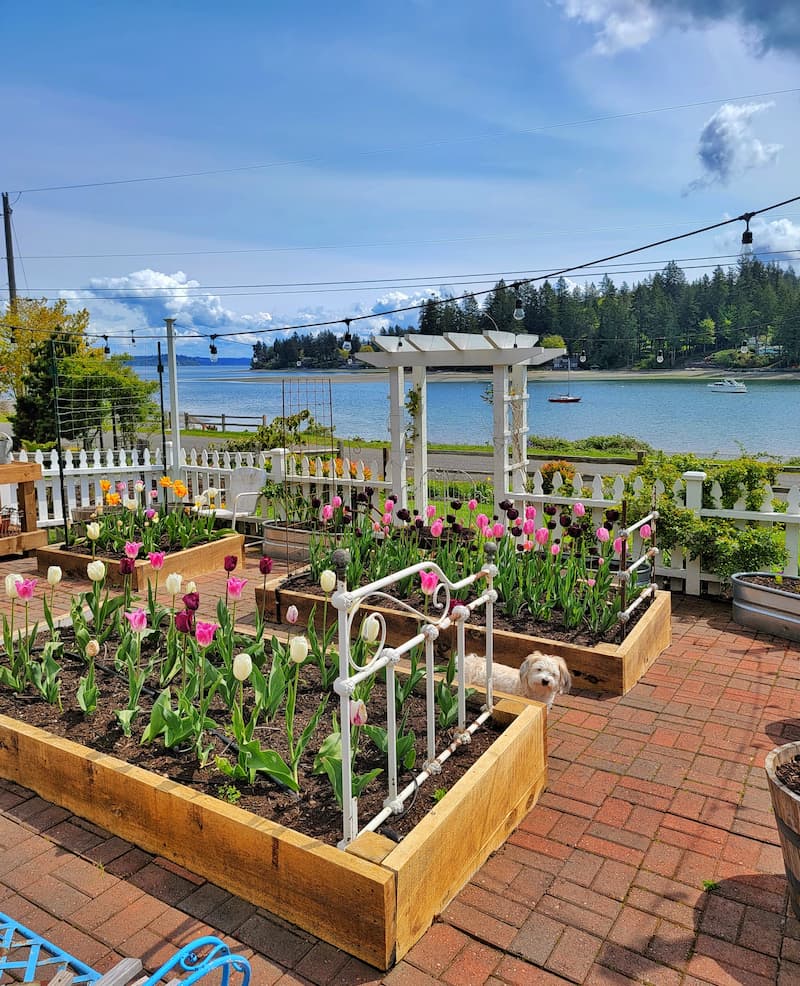
Dividing and Replanting Tulips
As tulip bulbs mature and multiply, they can become overcrowded, leading to smaller blooms and declining overall health.
Lifting and dividing tulip bulbs every 3 to 5 years is advisable, ideally in the late summer or early fall when the foliage has died back and the bulbs have entered dormancy.
Carefully dig up the bulbs, not damaging them, and gently brush off any soil. This is also an opportune time to inspect the bulbs for signs of disease or damage, discarding any that are not healthy. Separate the bulbs, keeping the offsets (smaller bulbs that form around the base of a mother bulb) large enough to flower.
Replant the bulbs immediately at their proper depth and spacing in a well-drained location with ample sunlight. This process rejuvenates your tulip display by giving each bulb more space and resources to grow. It also allows you to expand your garden’s color and variety by spreading the bulbs to new areas or sharing them with fellow gardeners.
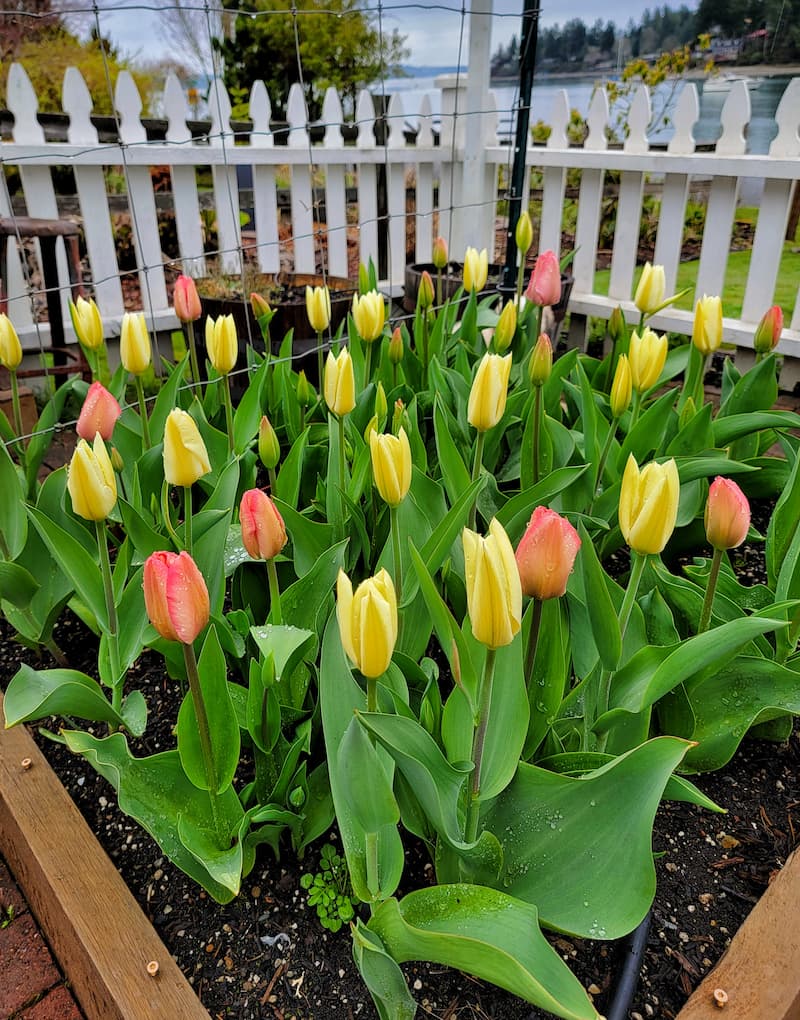
Common Questions Asked About Growing and Caring for Tulips
What are the Best Companion Plants for Tulips?
Ideal companions include low-growing perennials and annuals that complement the height and colors of tulips without overshadowing them.
Pansies, forget-me-nots, and violas offer a beautiful color contrast and bloom simultaneously as tulips, creating a layered effect in the garden.
Ground covers like creeping phlox or sedum add texture and interest at the base of tulips and help keep the soil moist and weed-free.
For a more structured look, planting tulips alongside ornamental grasses or in front of shrubs like boxwood can provide a striking backdrop.
Mixing other spring bulbs, such as daffodils, hyacinths, and alliums, can extend the blooming season and add variety to the seasonal garden.
You can create a harmonious and thriving garden space by carefully selecting companion plants with similar sunlight and watering needs.
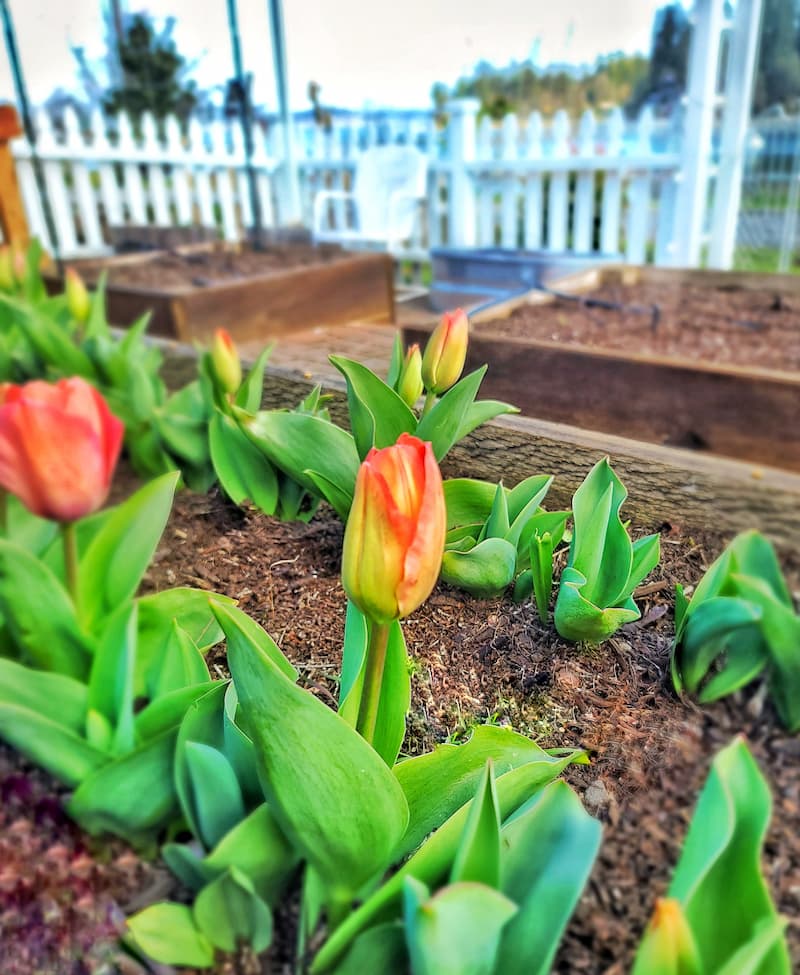
What is the Ideal Location to Plant Tulip Bulbs?
Tulips require a location that receives full to partial sunlight, with at least 6 hours of direct sunlight daily being optimal. This exposure is crucial for the development of strong stems and vivid flowers.
The soil in the chosen location should be well-drained and fertile, as tulips do not thrive in waterlogged conditions, which can lead to bulb rot.
Enhancing the soil with organic matter, such as compost, can improve drainage and nutrient content, creating an ideal growing medium. A slightly acidic to neutral soil pH, ranging from 6.0 to 7.0, is also preferable.
Consider the location’s exposure to wind. Tulips can be susceptible to damage from strong winds, so a site that offers some protection, or planting tulips near a structure or other plants that can act as a windbreak, can be beneficial.
Planting tulips in groups or drifts in areas where they will be visible, such as along walkways, borders, or in front of evergreen backdrops, can enhance the aesthetic appeal of your garden in the spring.
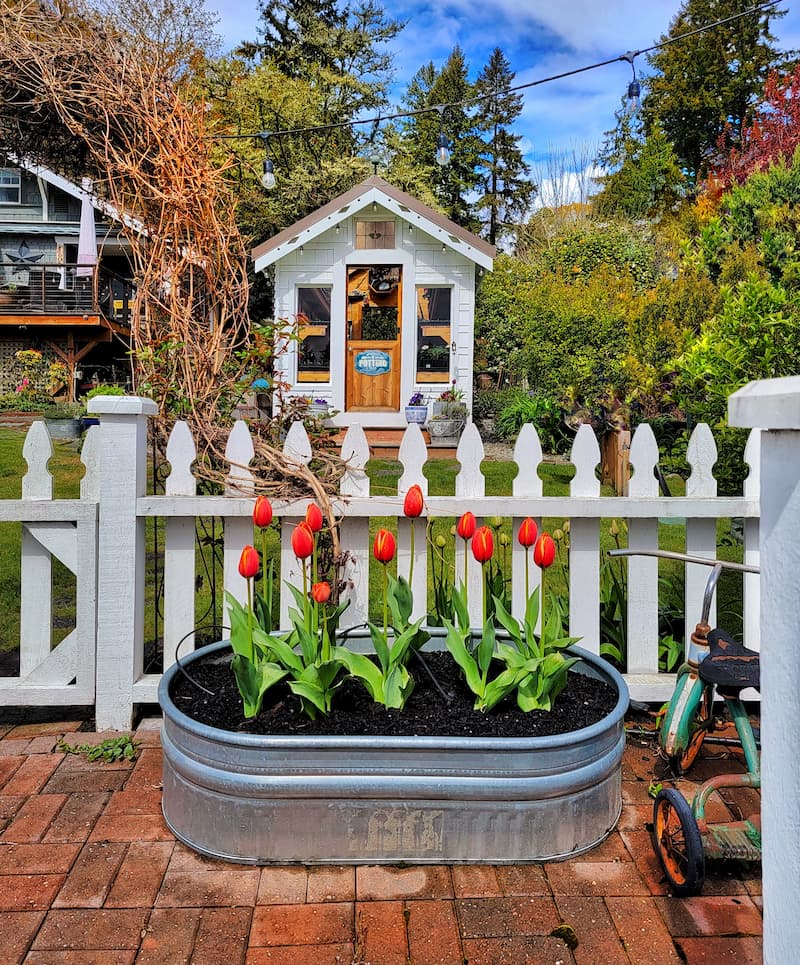
Can you Grow Tulips in Containers?
Growing tulips in a pot or container is an excellent way to enjoy their vibrant colors and elegant shapes if you have limited garden space or wish to decorate patios, balconies, and other outdoor areas.
Container gardening with tulips allows for greater control over the growing conditions, particularly the soil drainage, which is crucial for tulip health.
To successfully grow tulips in containers, choose a pot around 12 inches deep to accommodate the bulb’s root growth and ensure it has adequate drainage holes to prevent waterlogging. A well-draining potting mix, ideally formulated for bulbs, provides the right moisture retention and drainage balance.
When planting, you can place the bulbs closer together in containers than in the ground, but they should not touch each other or the sides of the pot.
Layering different types of tulip bulbs at varying depths can create a prolonged and stunning display as each variety blooms in succession.
Remember to place the containers in a location that receives enough sunlight and consider the temperature, as containers can cool down faster than the ground, potentially requiring some protection during extreme cold.
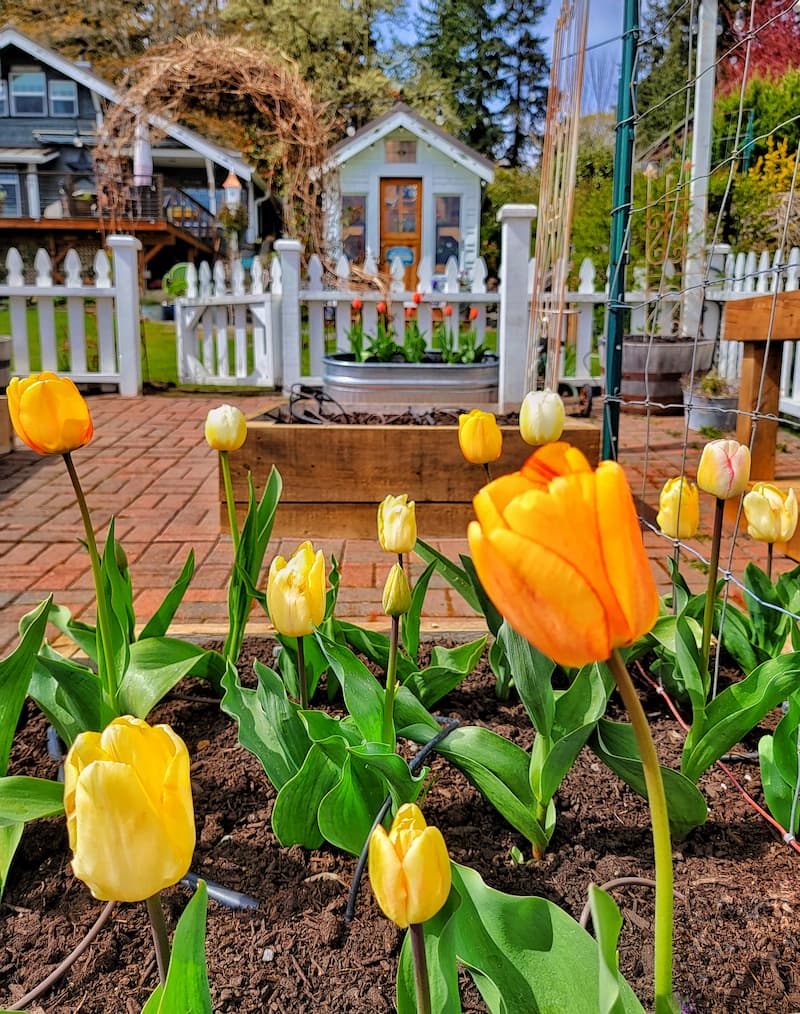
Final Thoughts About Growing and Caring for Tulips
By understanding the essential aspects of tulip care, from selecting the ideal planting location and ensuring proper soil conditions to mastering the tasks of watering, fertilization, and pest management, gardeners can maximize the health and beauty of their tulip gardens.
Incorporating practices like deadheading, dividing, and choosing companion plants can enhance tulip blooms’ visual appeal and longevity.
With some preparation and ongoing care, these popular spring flowers can become a special part of your garden landscape.
If you have any questions or additional suggestions, please share them in the comments below. And be sure to share this blog post link with anyone who may find these gardening tips on growing and caring for tulips valuable.
Until next time,
Happy Gardening!

I’m a self-taught hobby gardener. Everything I share on my blog is my opinion and what has worked for me.
YOU MAY ALSO
Enjoy These Posts
Follow Me for More Inspiration
Shop my Amazon Storefront, LTK sources, and my favorite home decor, garden, and lifestyle products. When you purchase from one of my links, I earn a small commission, which helps me continue sharing all the content you expect on my blog.
Follow me on Pinterest, Instagram, Facebook, TikTok and LIKEtoKNOW.it. Do you like gardening? Join my Facebook Gardening Tips & Tricks group.

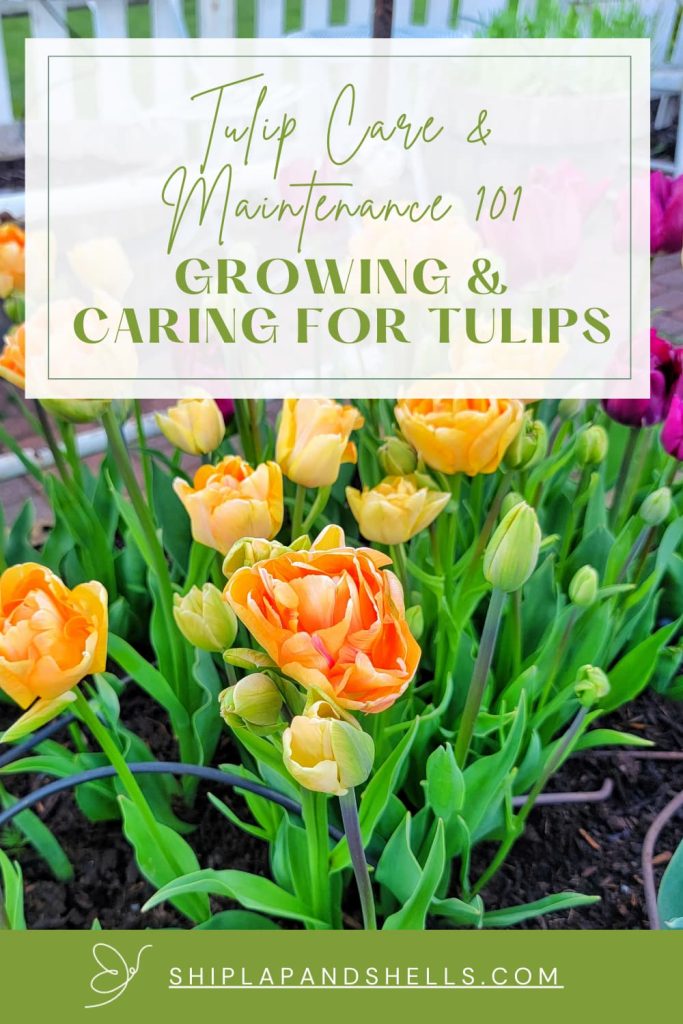


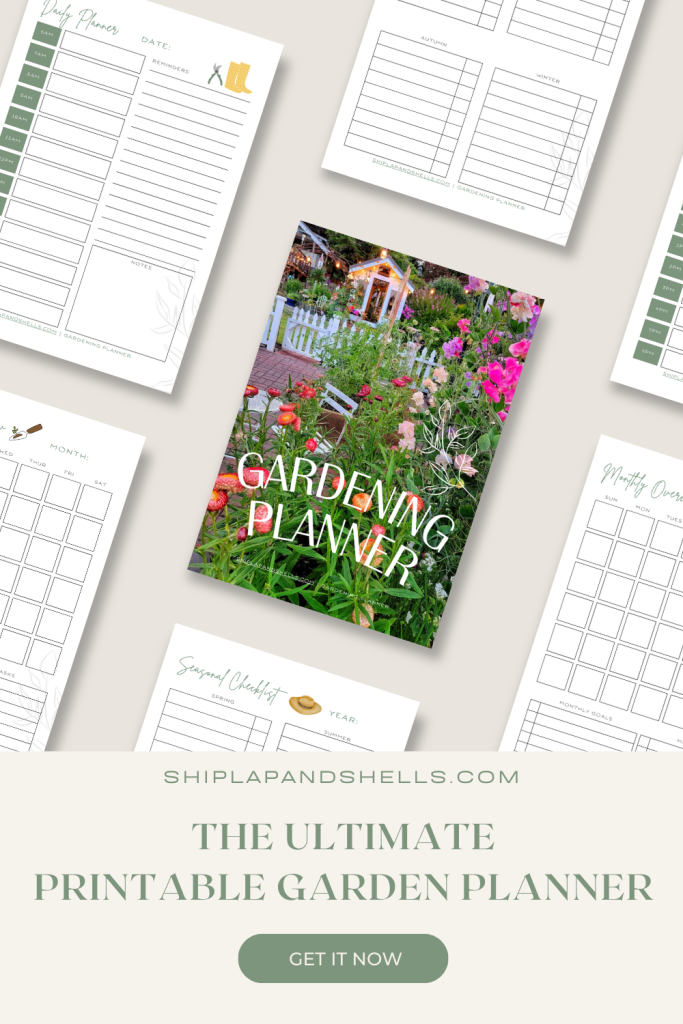
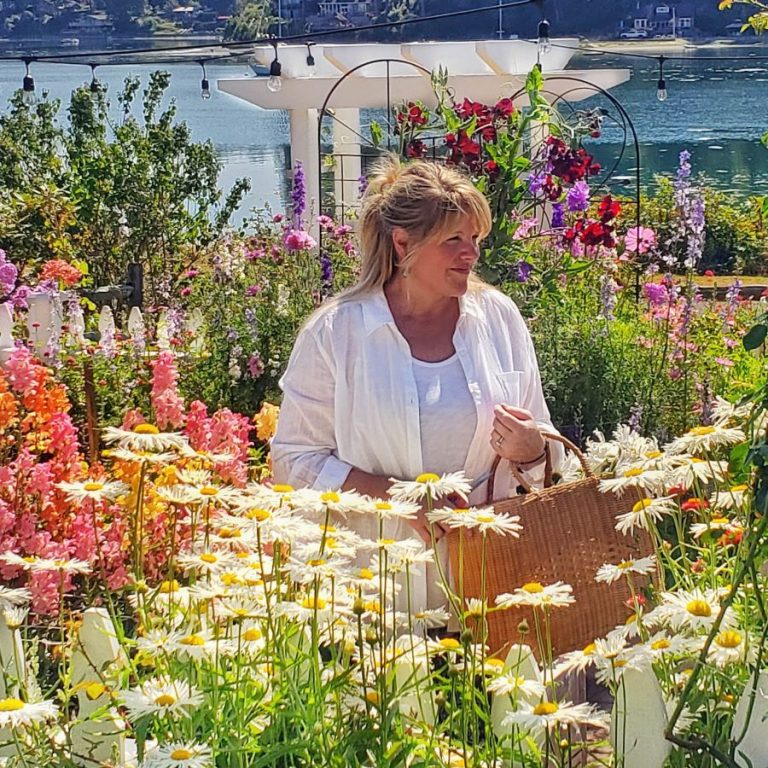

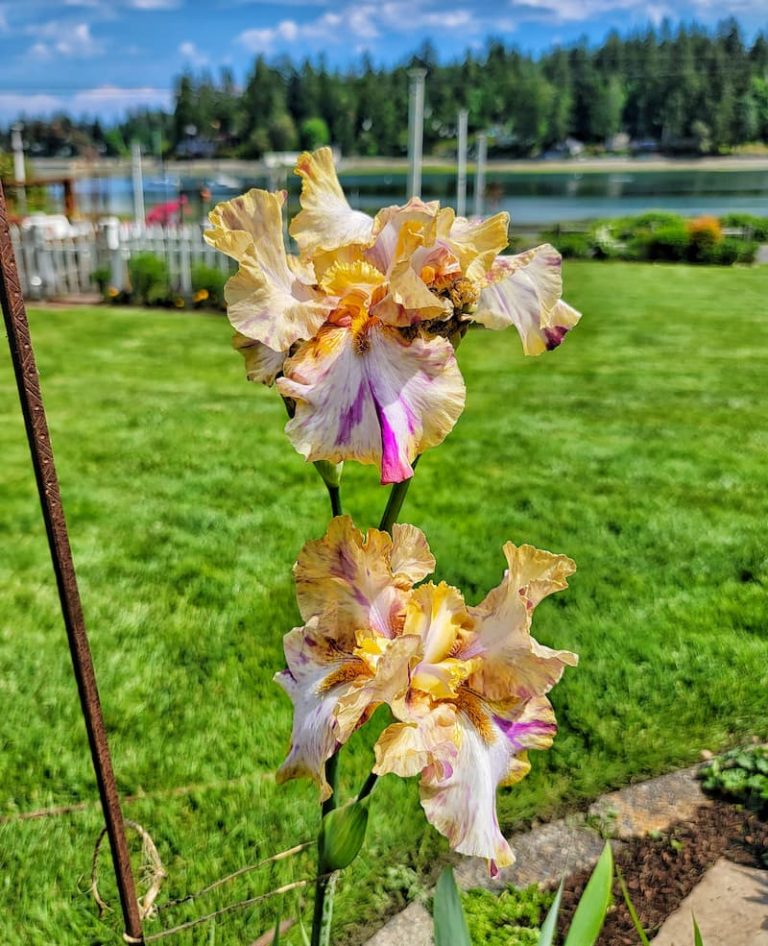
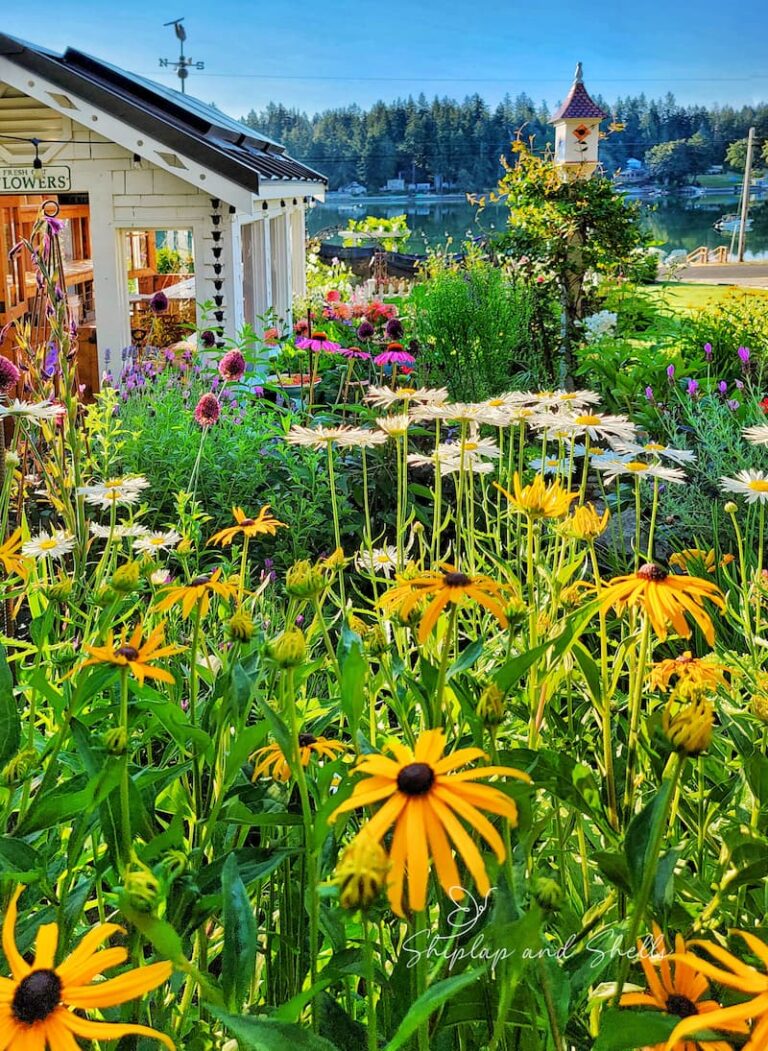
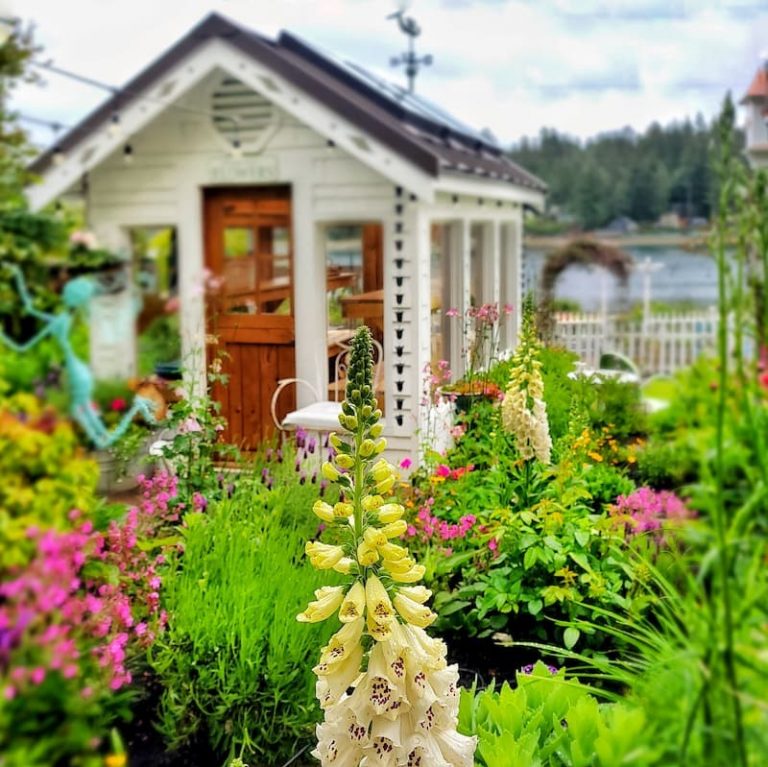
Wow! This is amazing! You could write a book on this. I love seeing your gorgeous gardens.
That is such a wonderful compliment Renae. Thank you my friend.